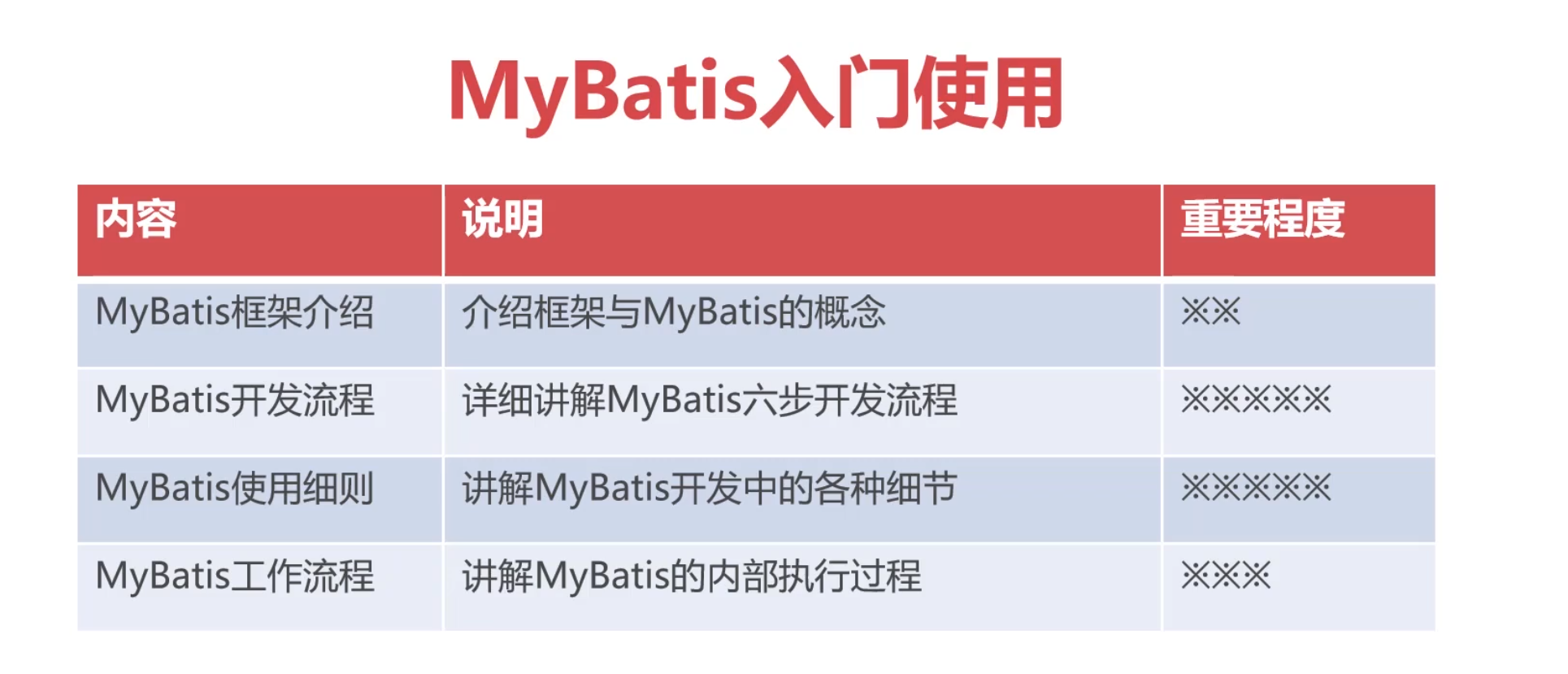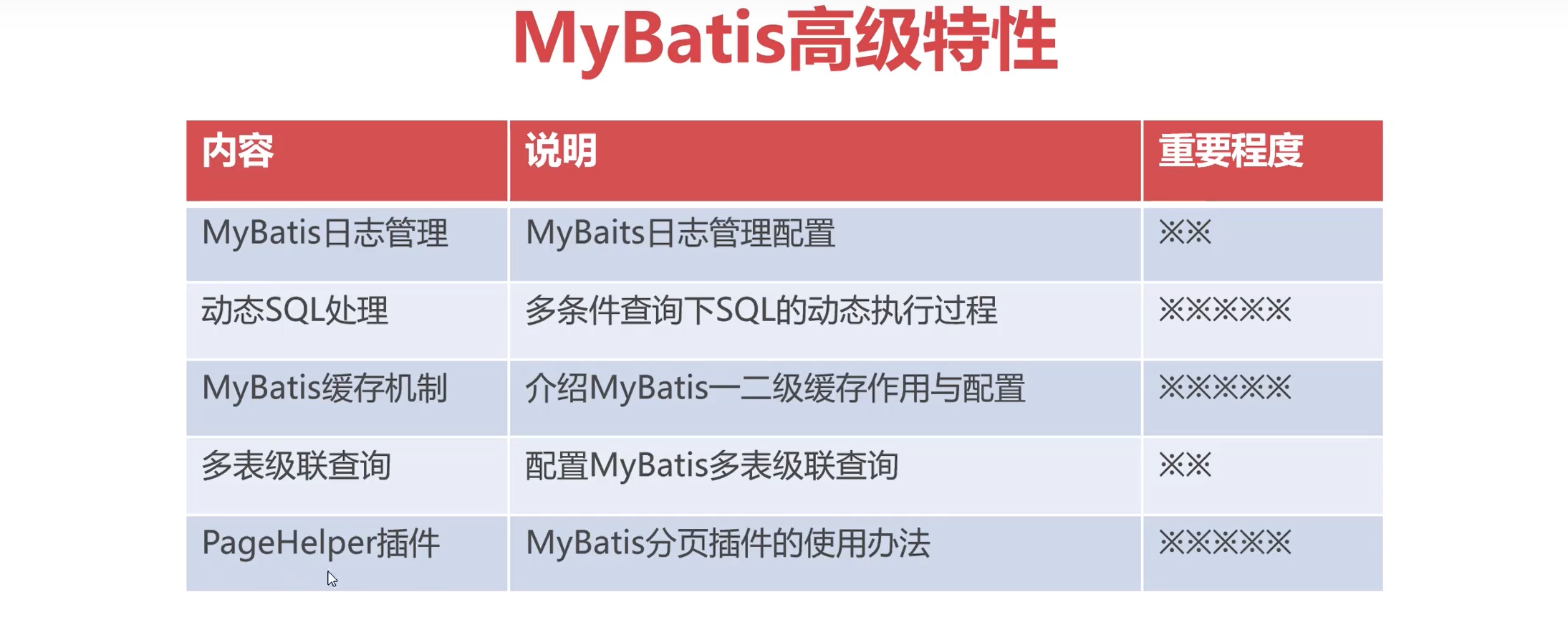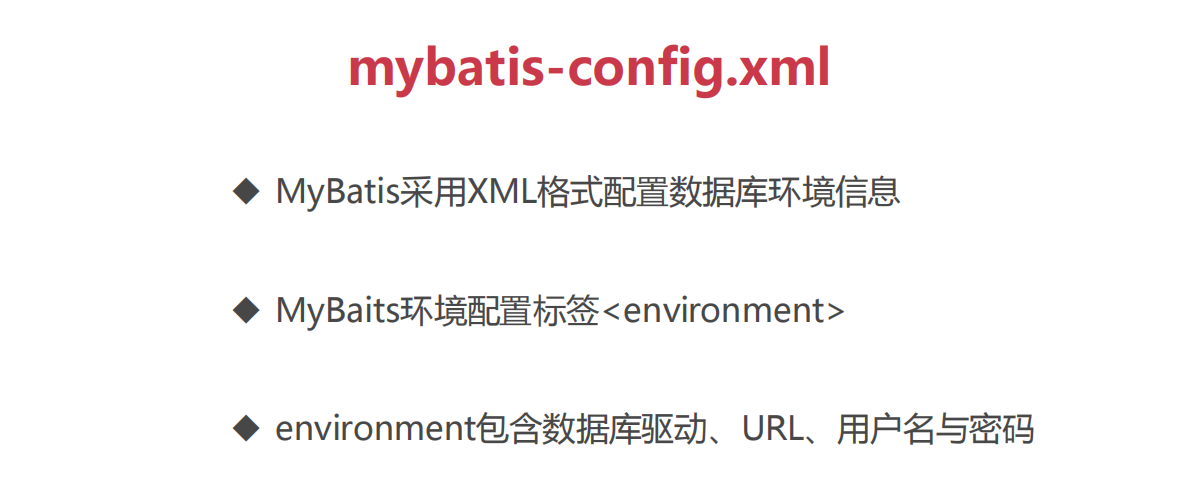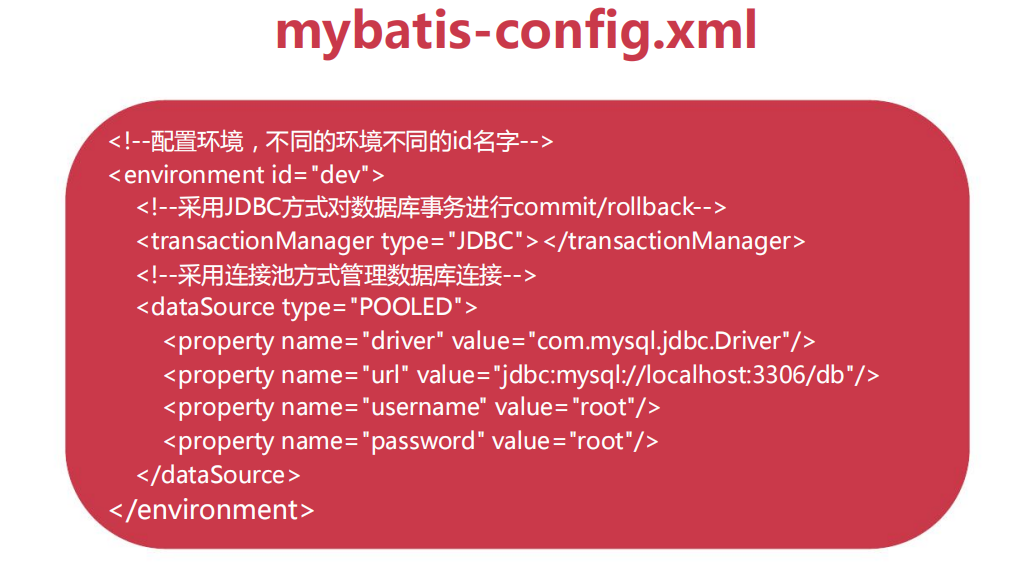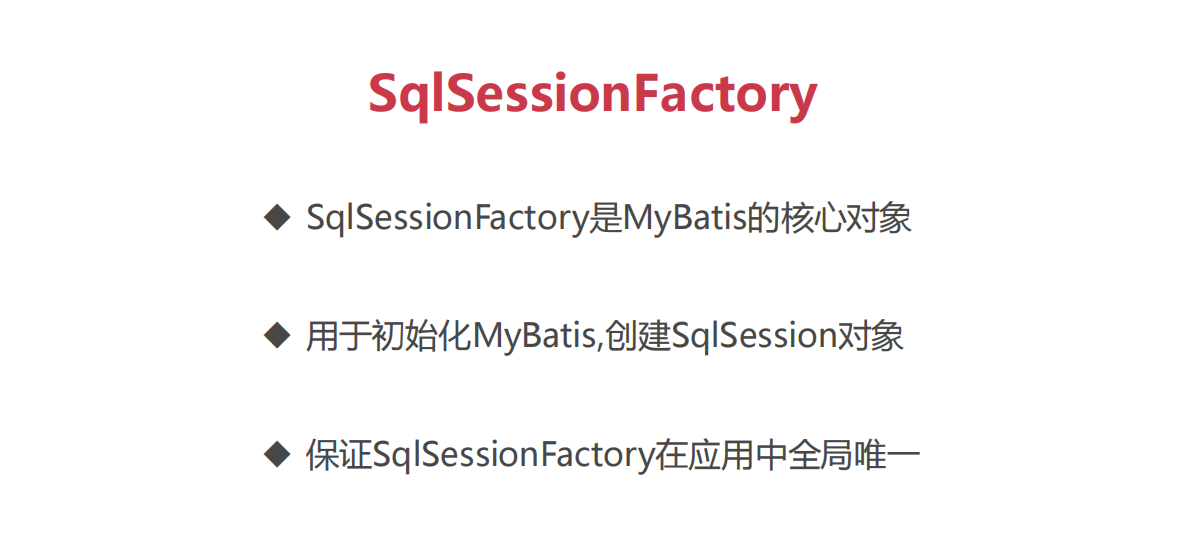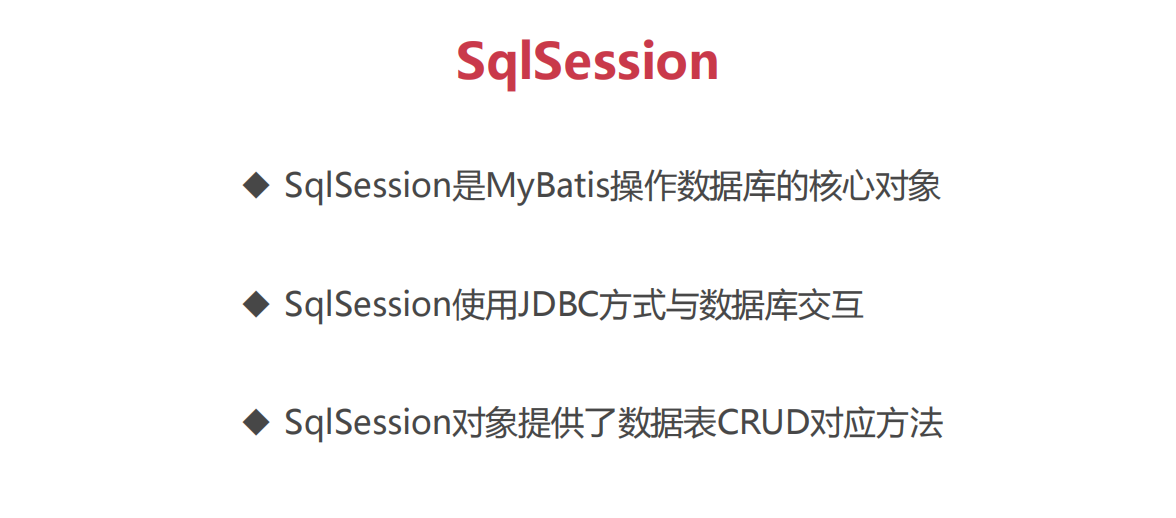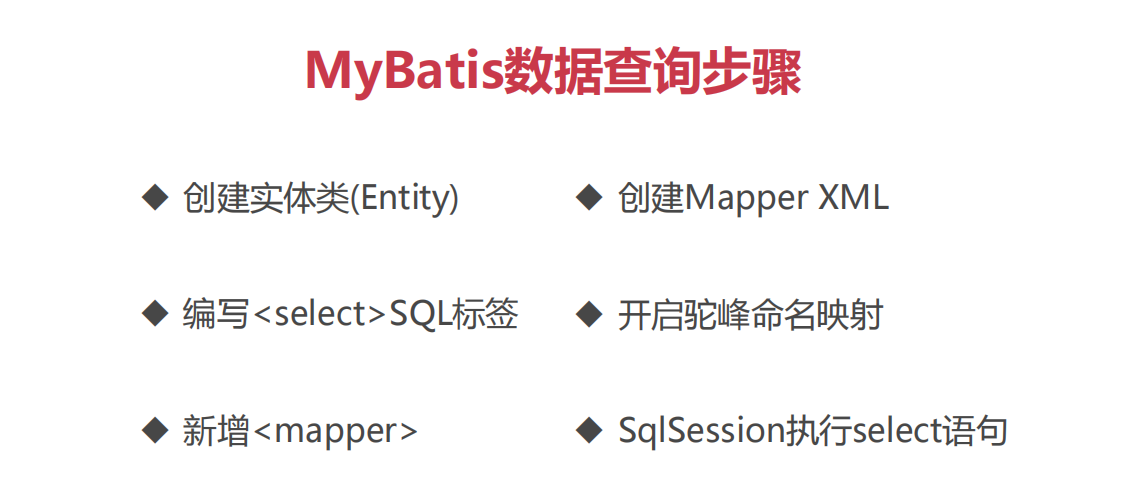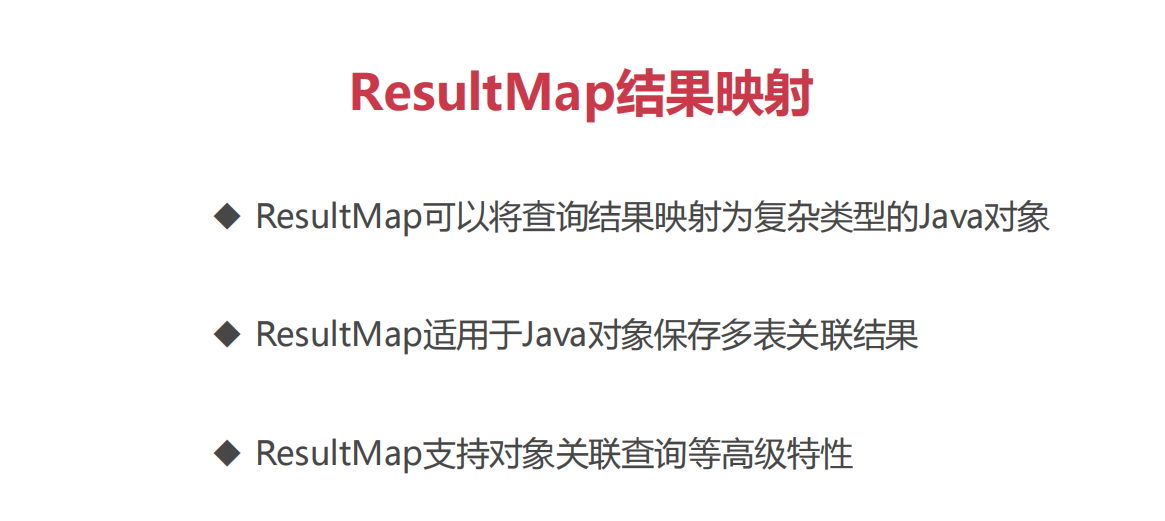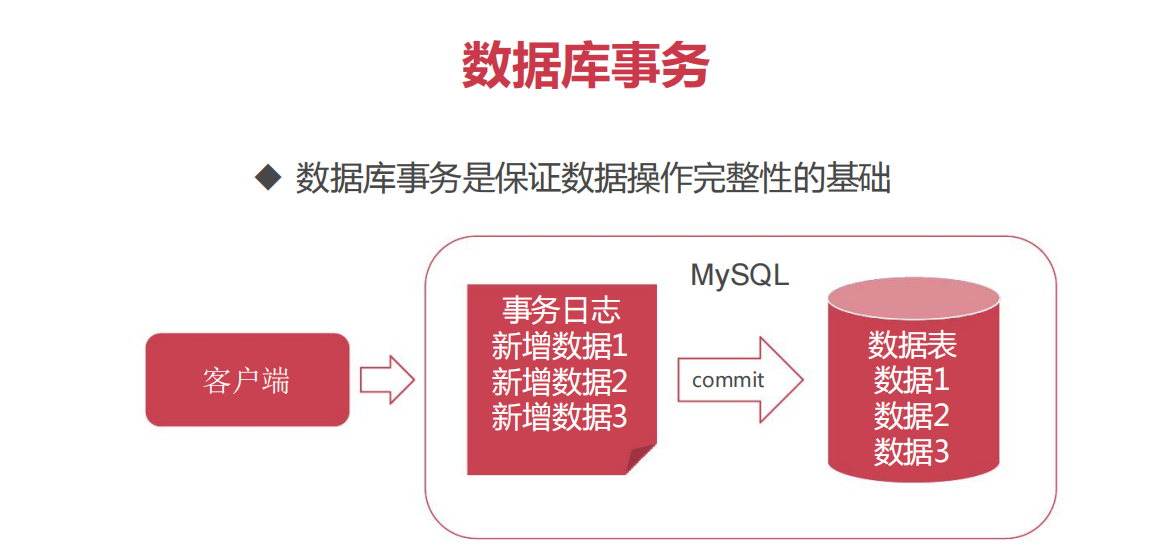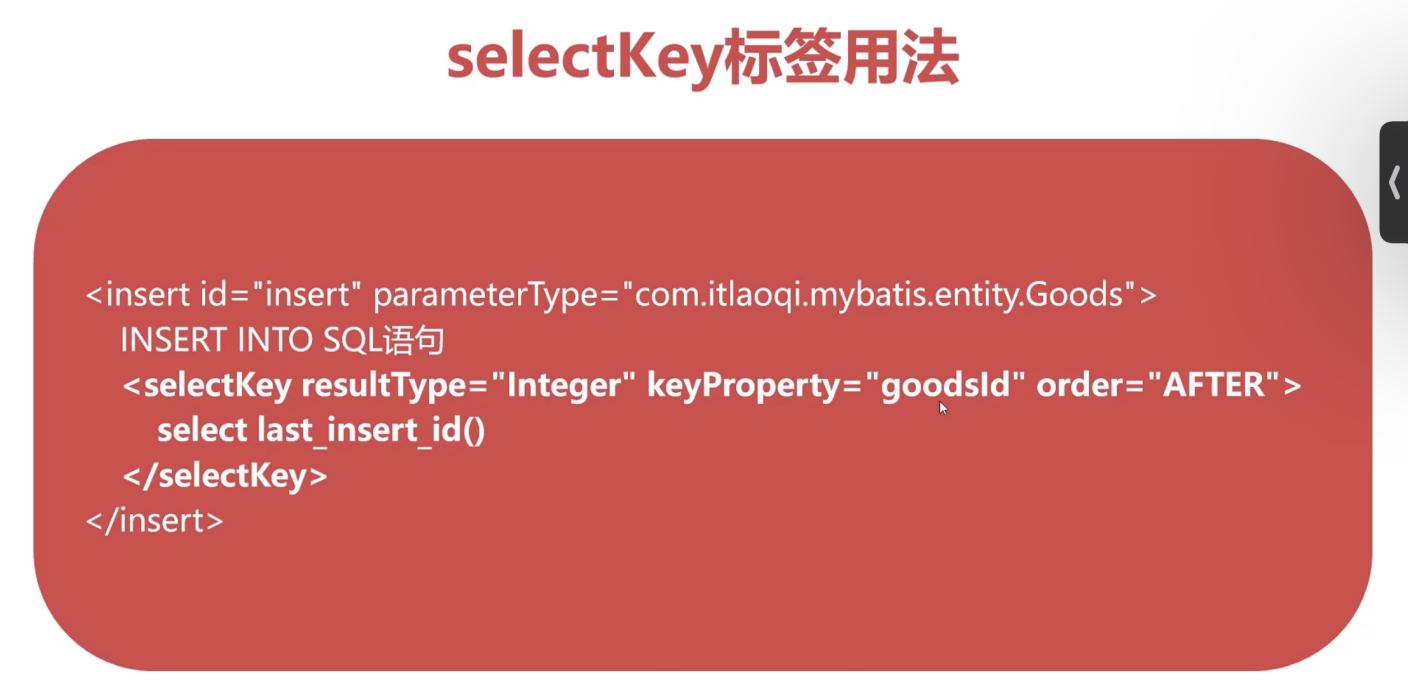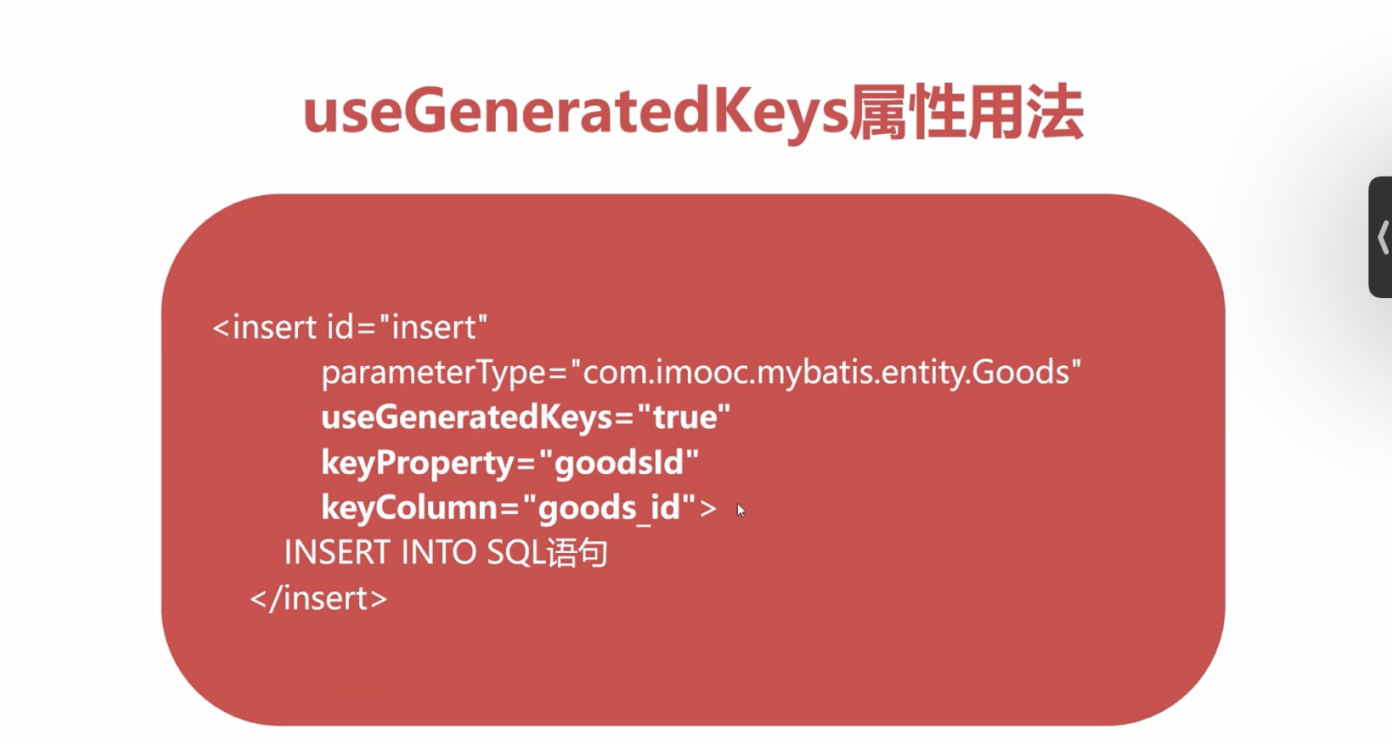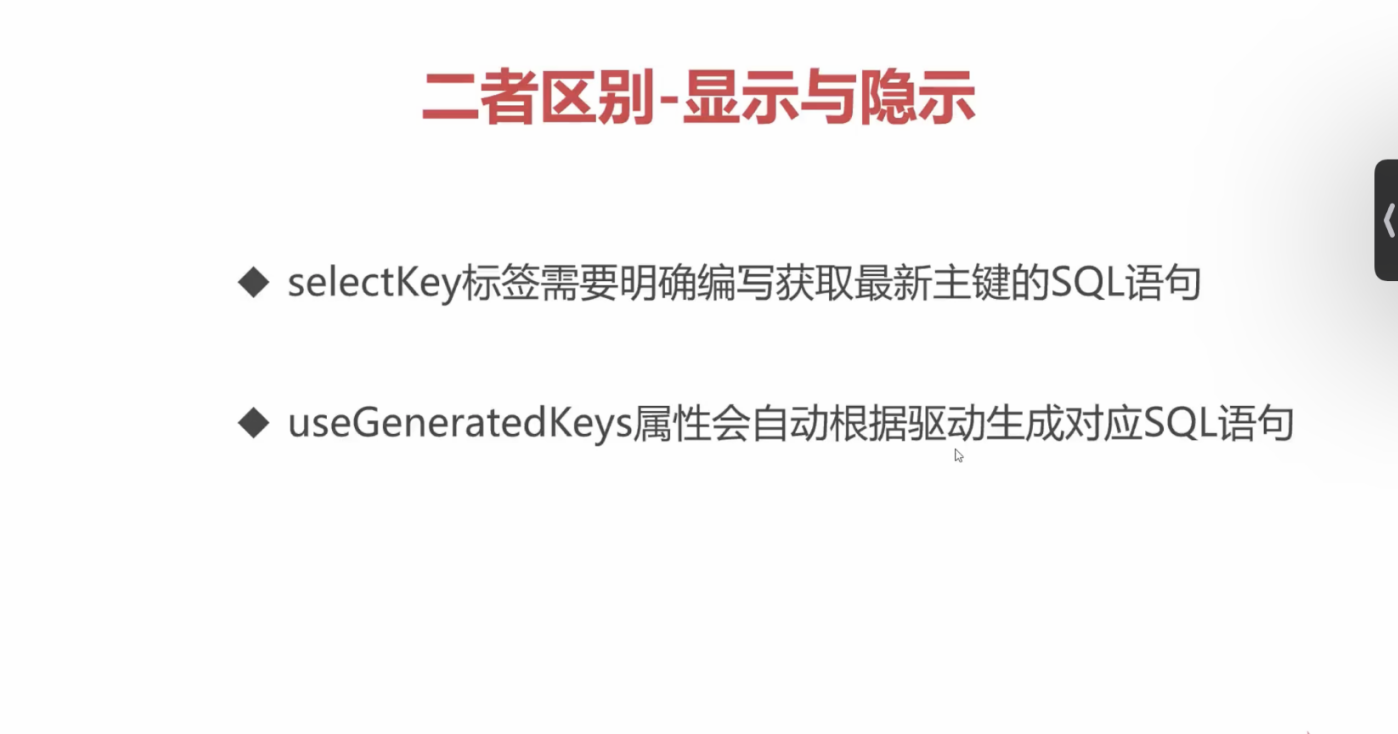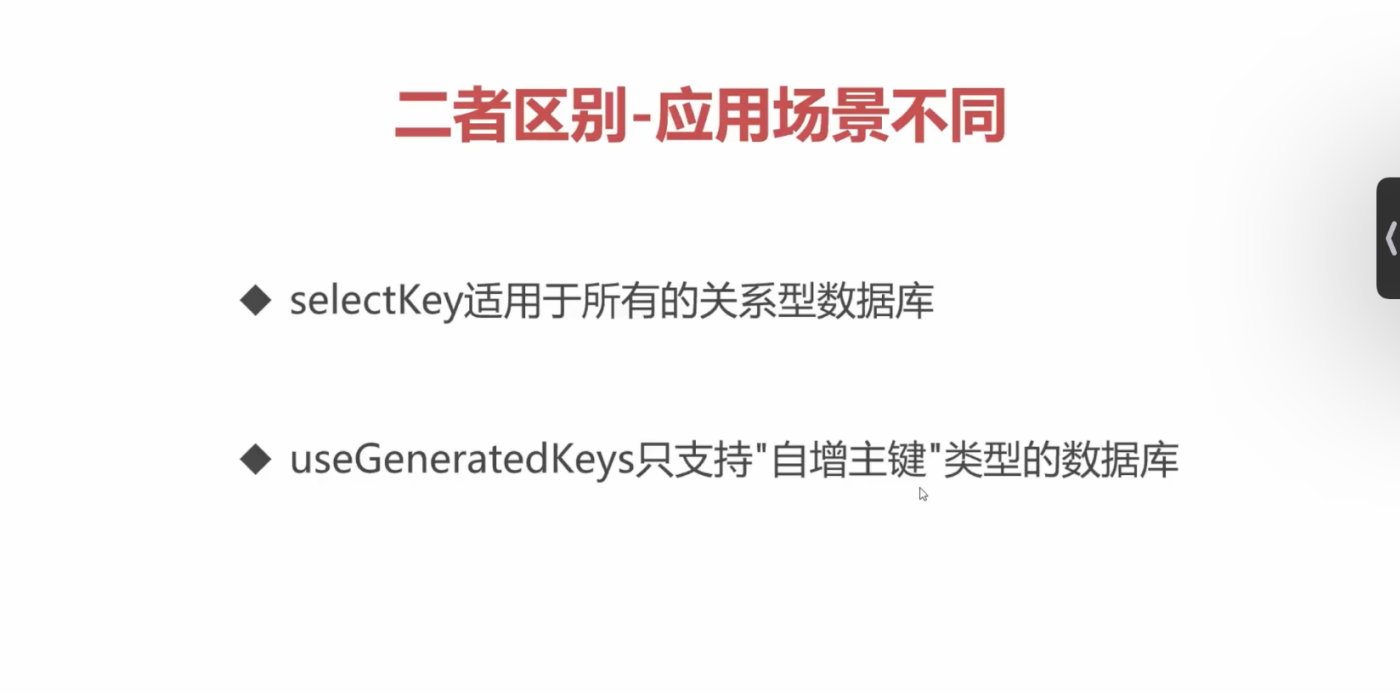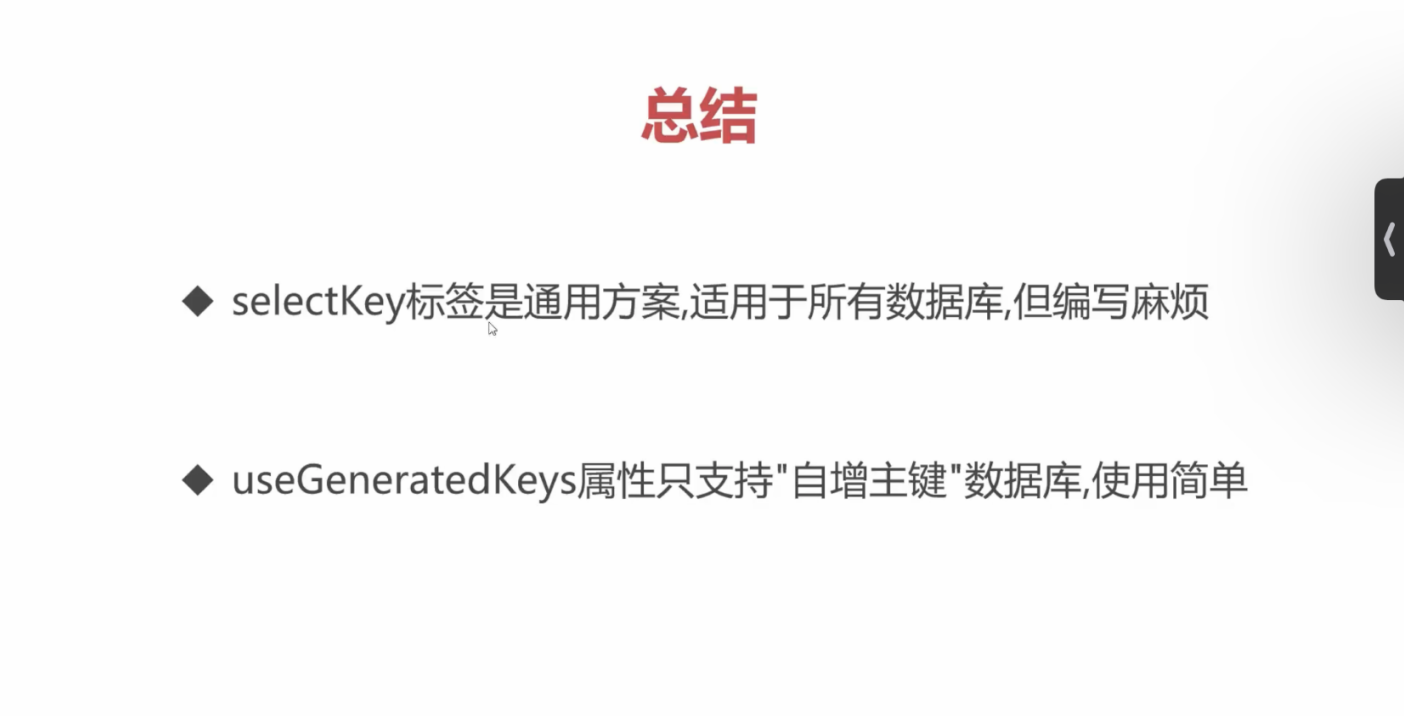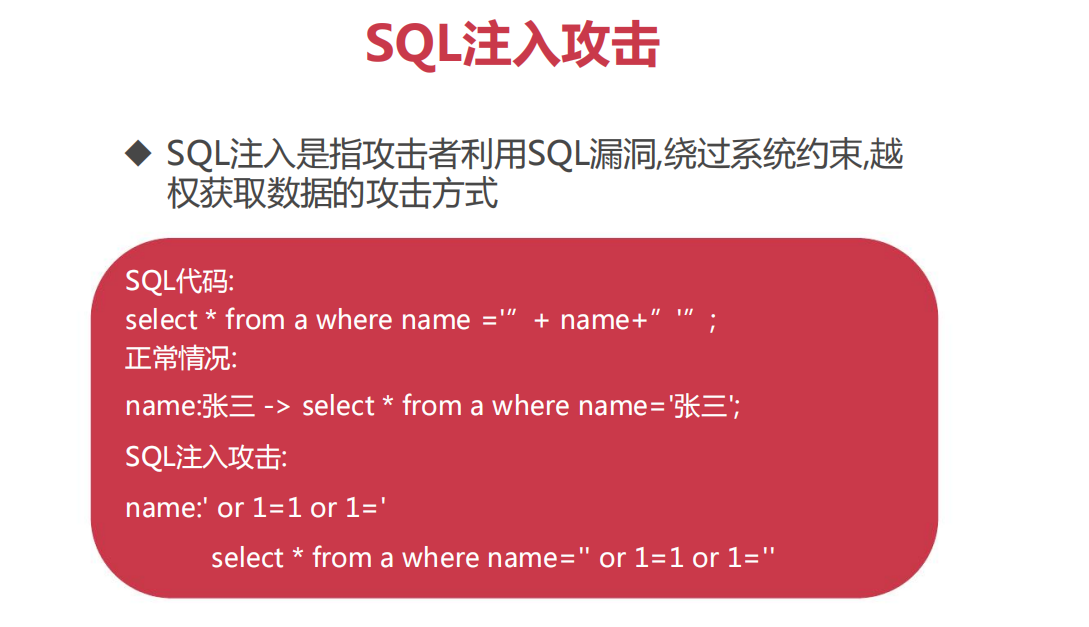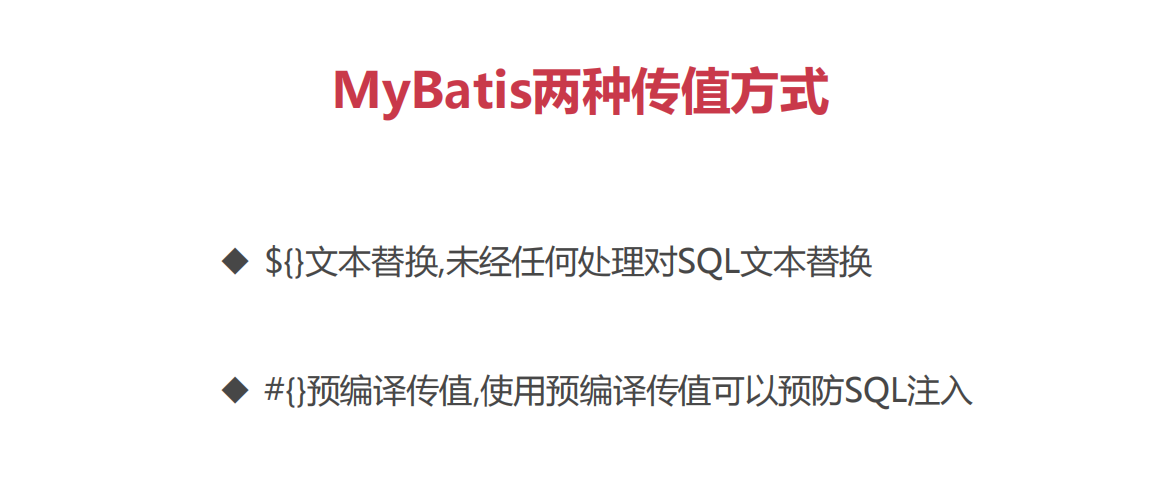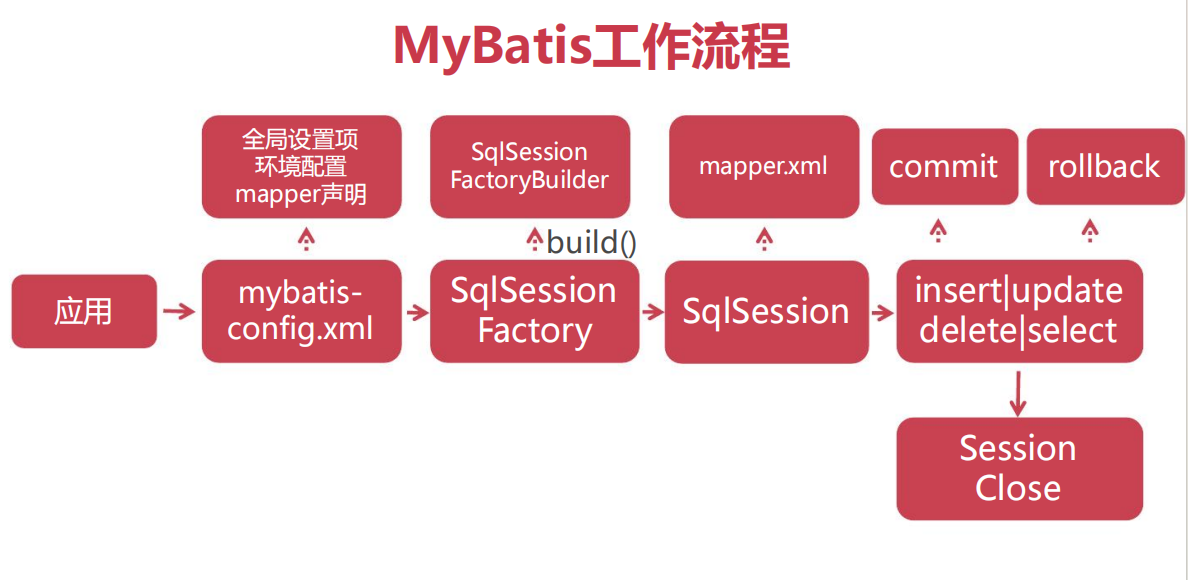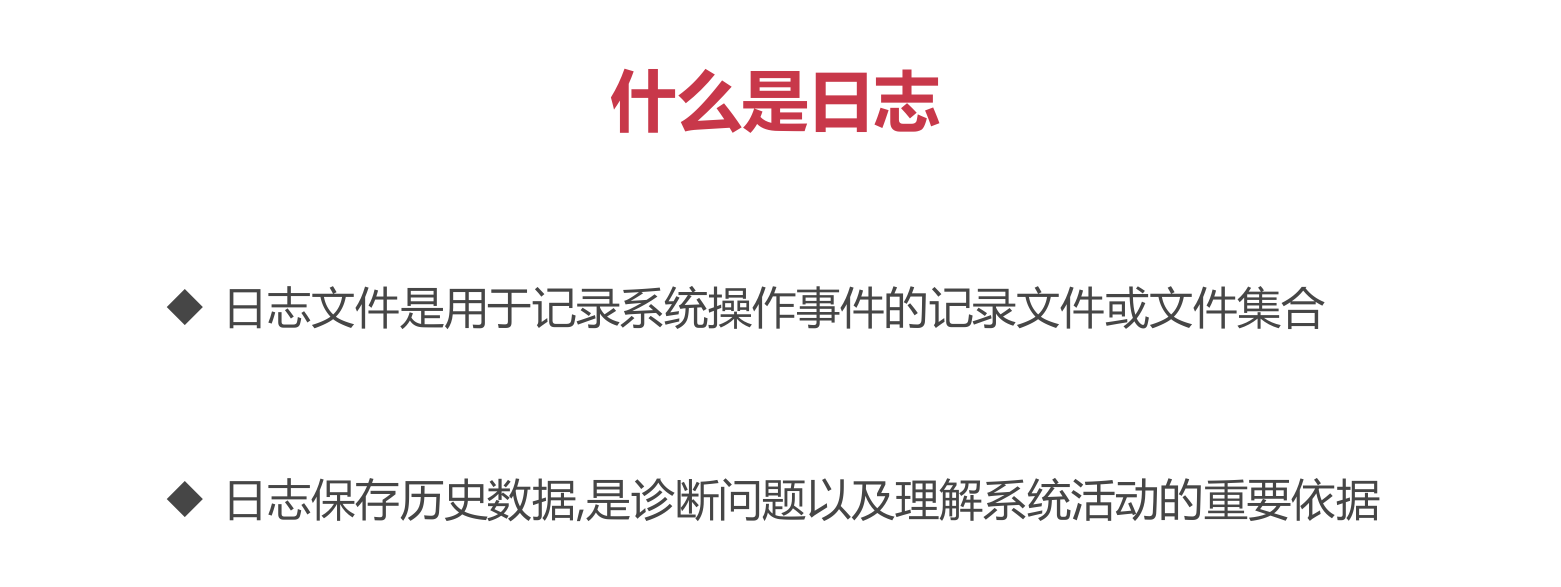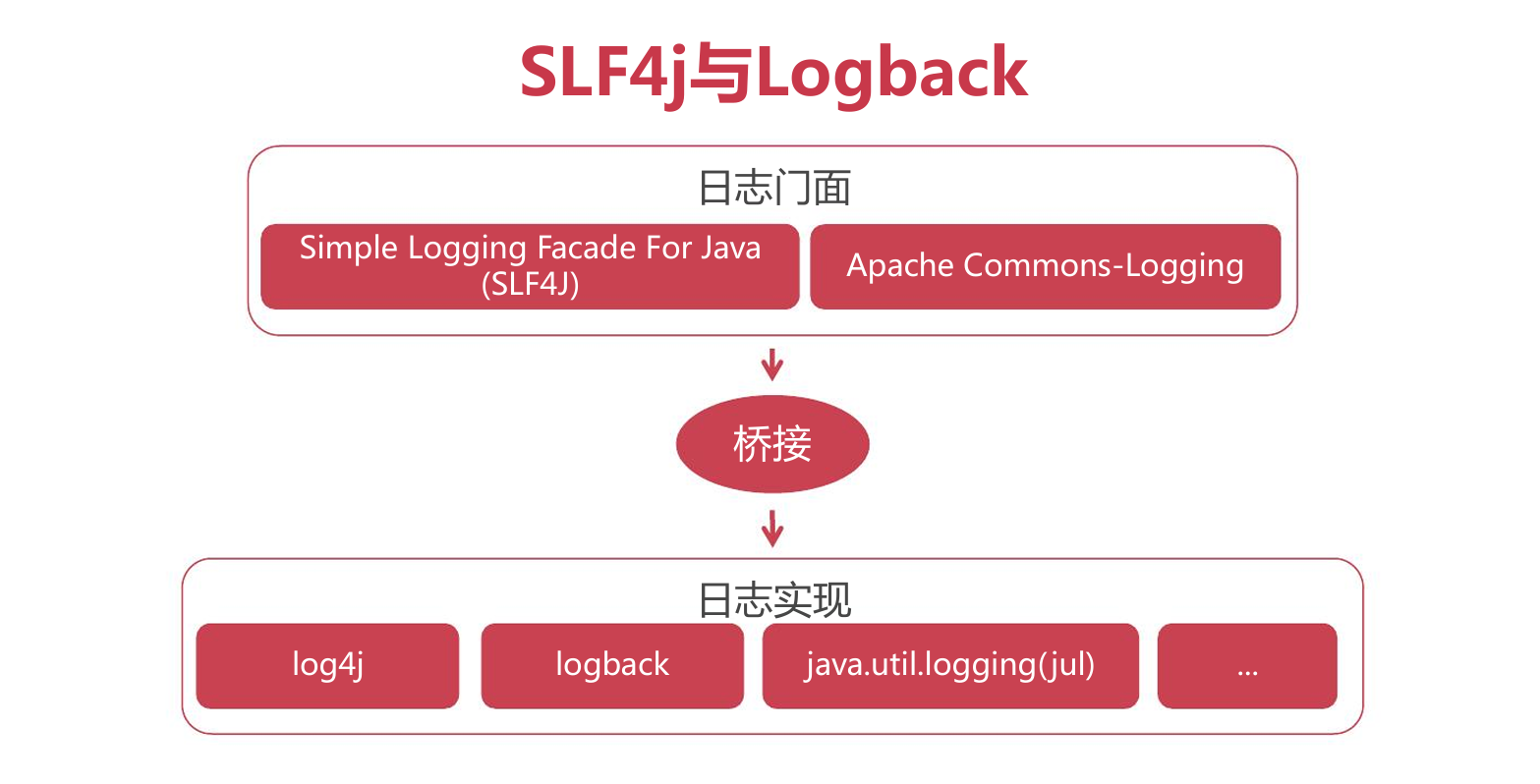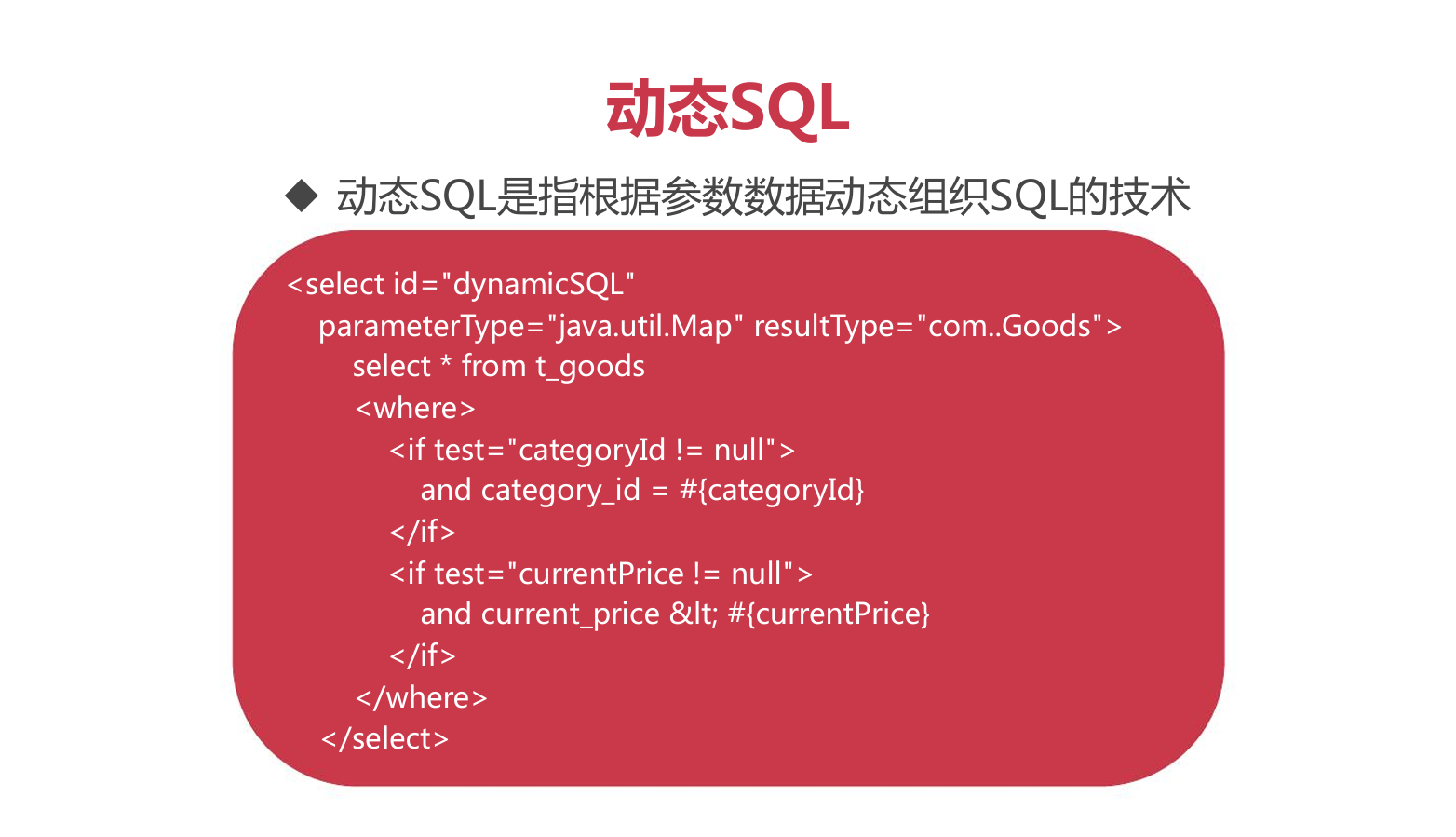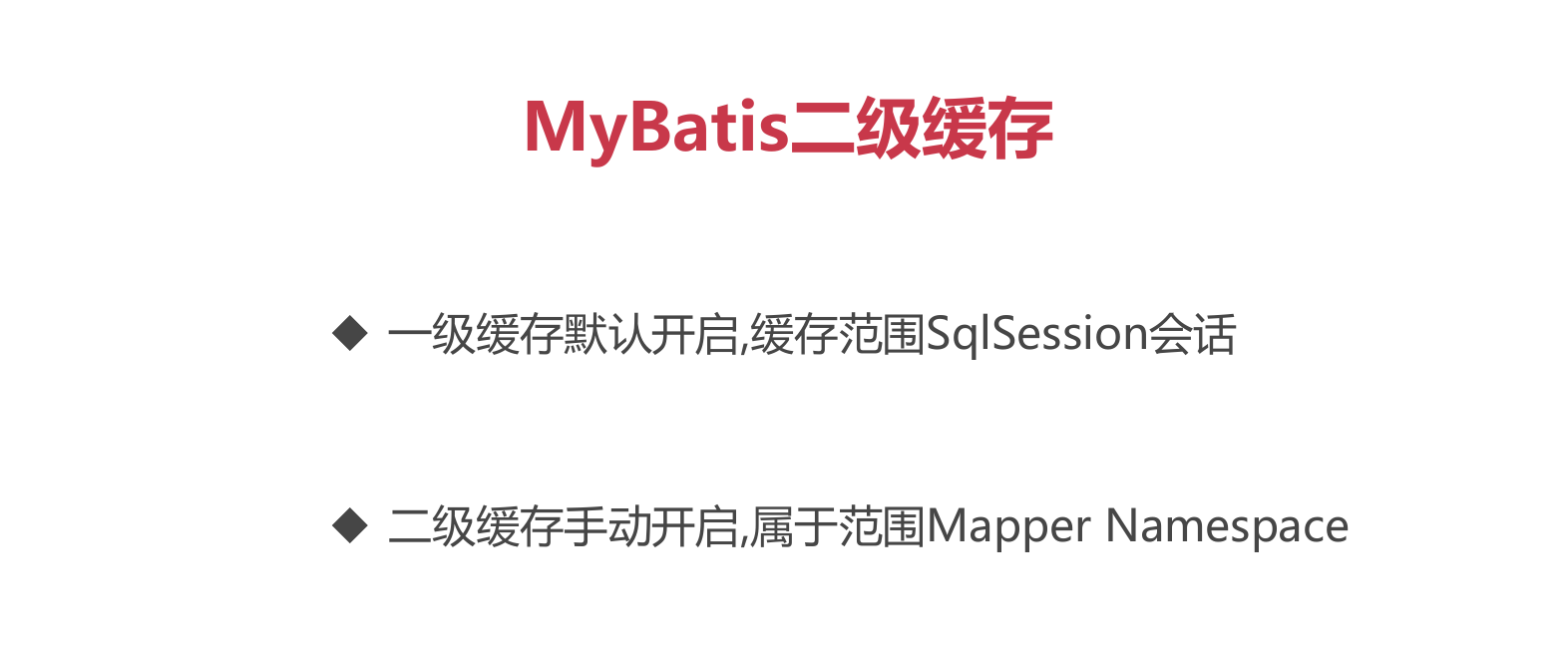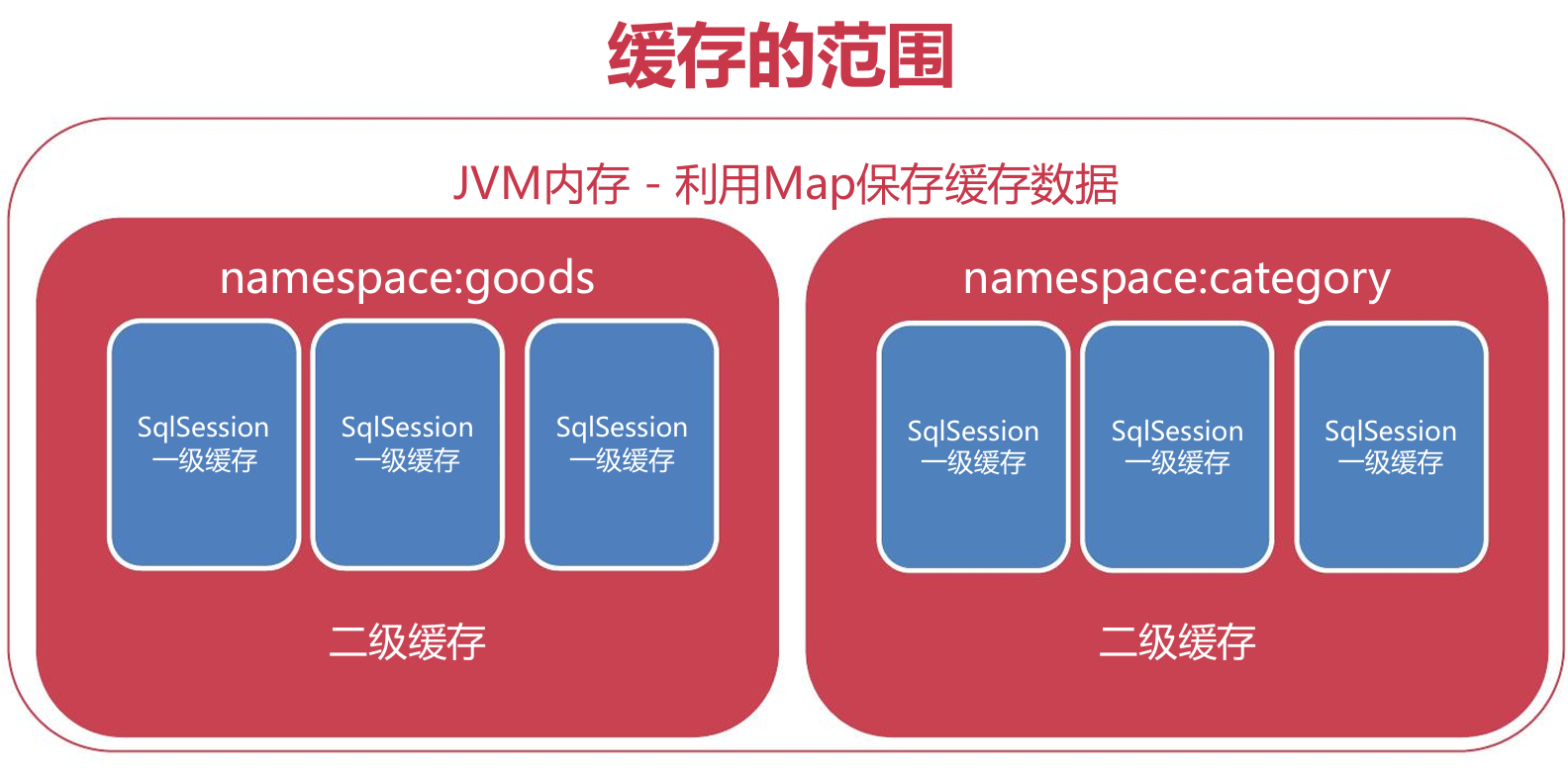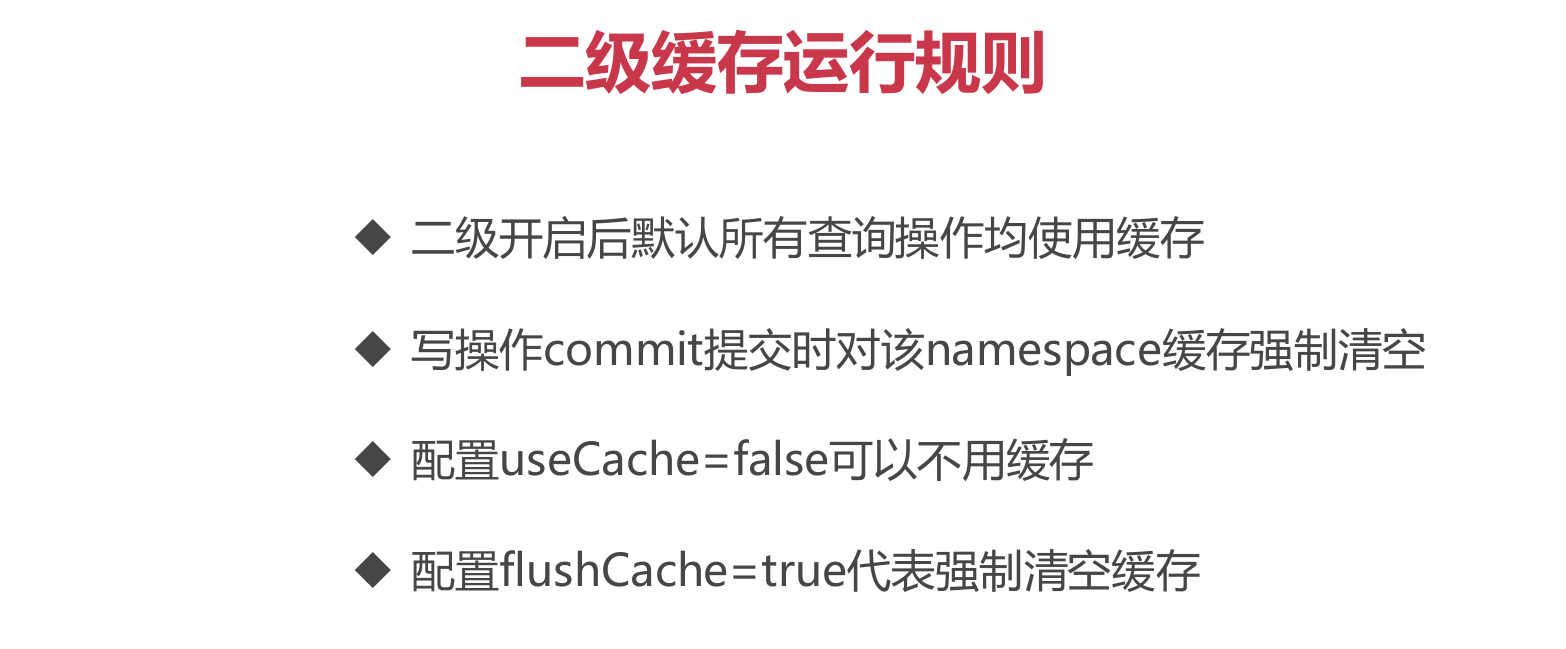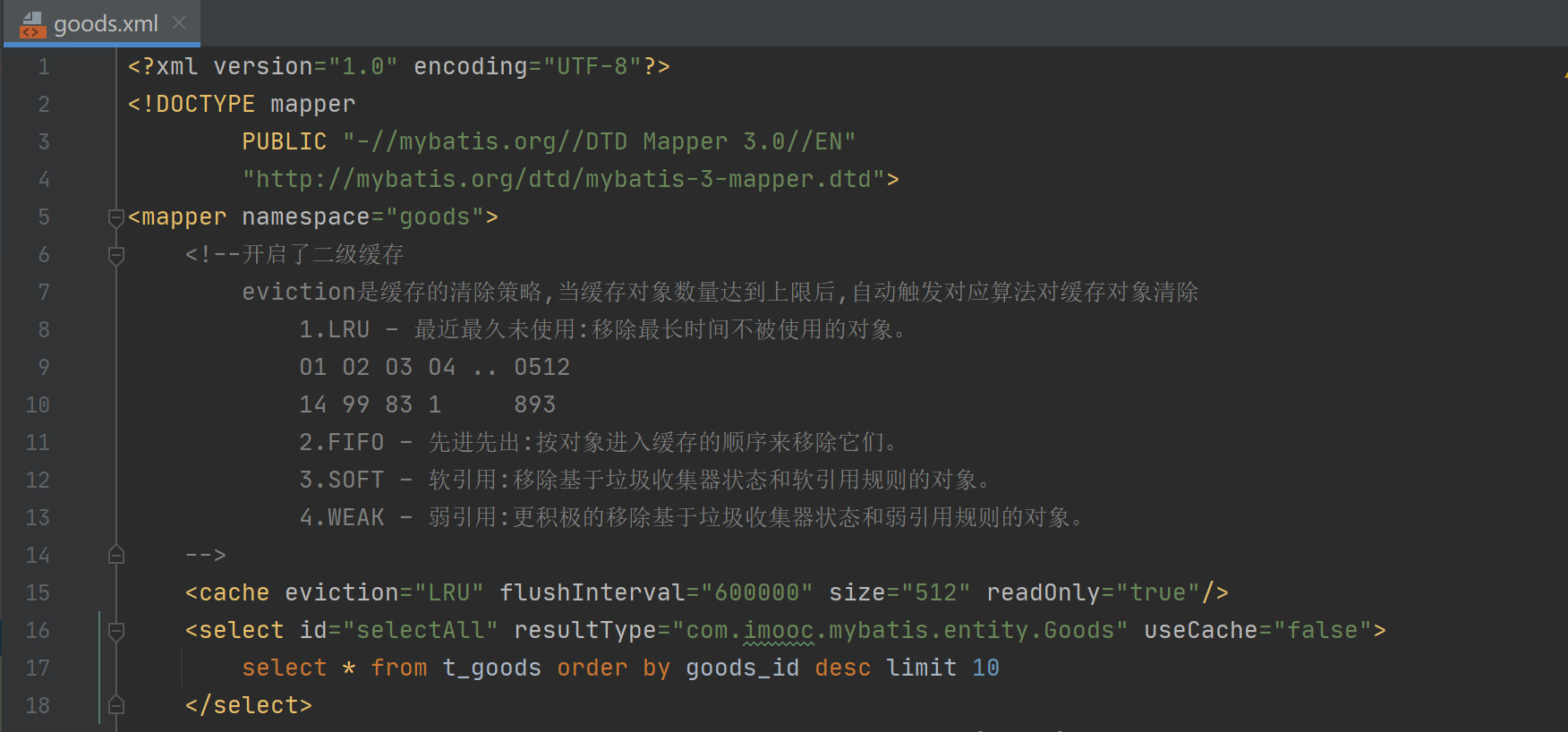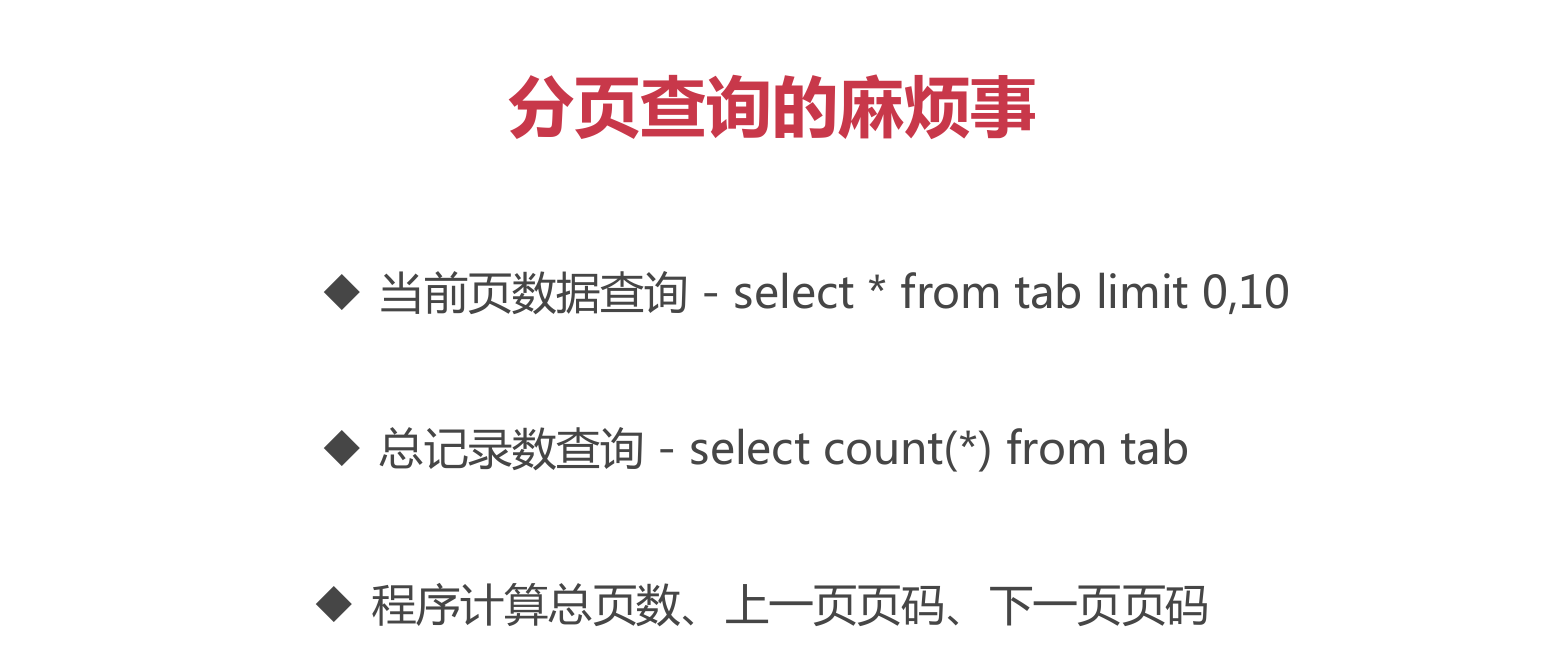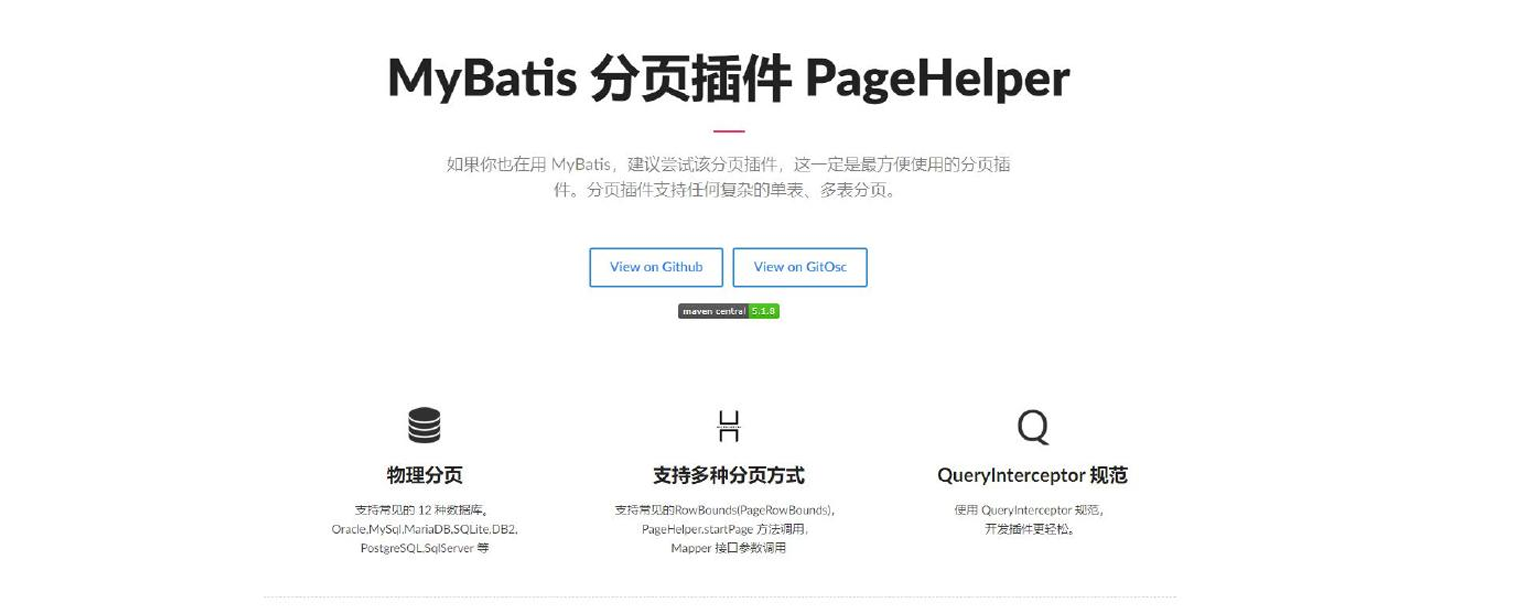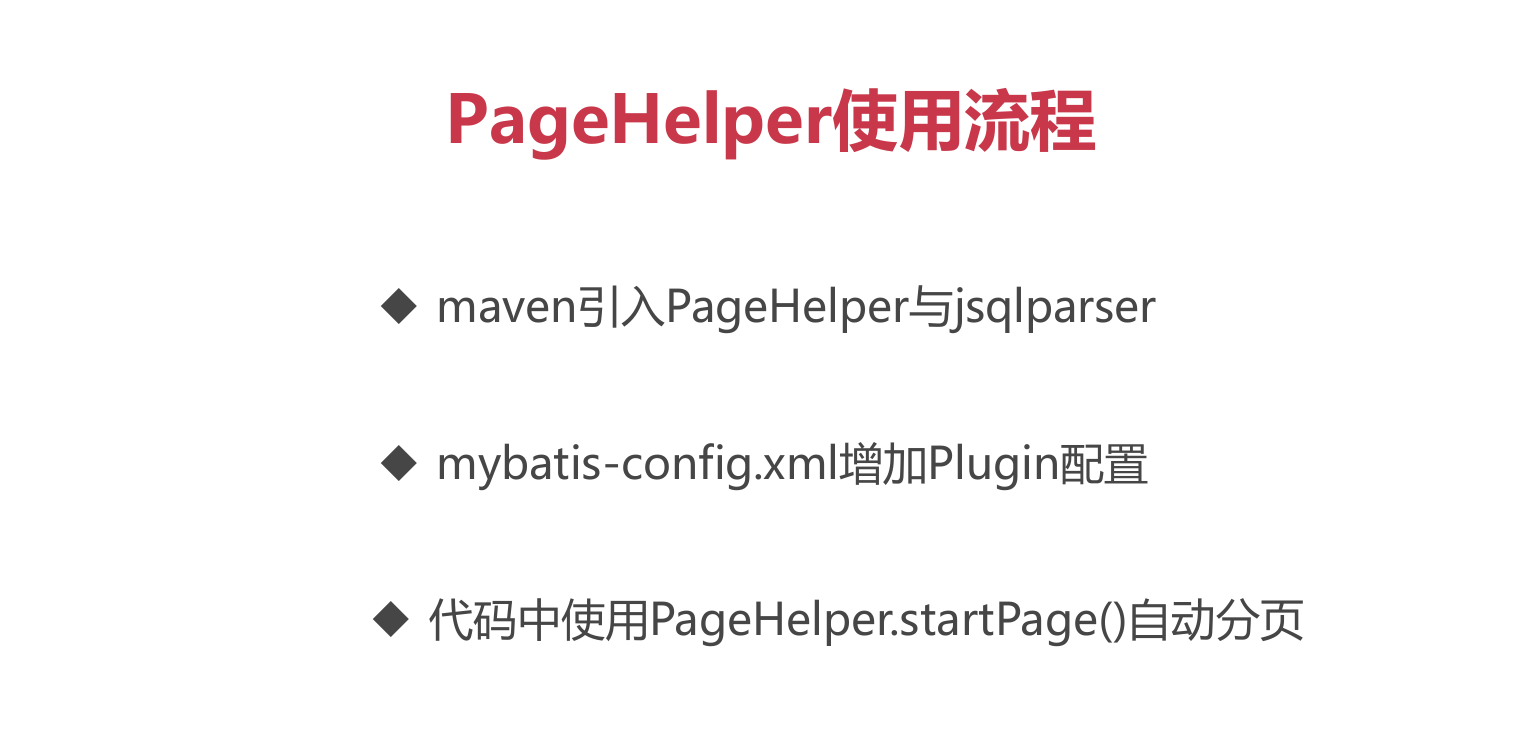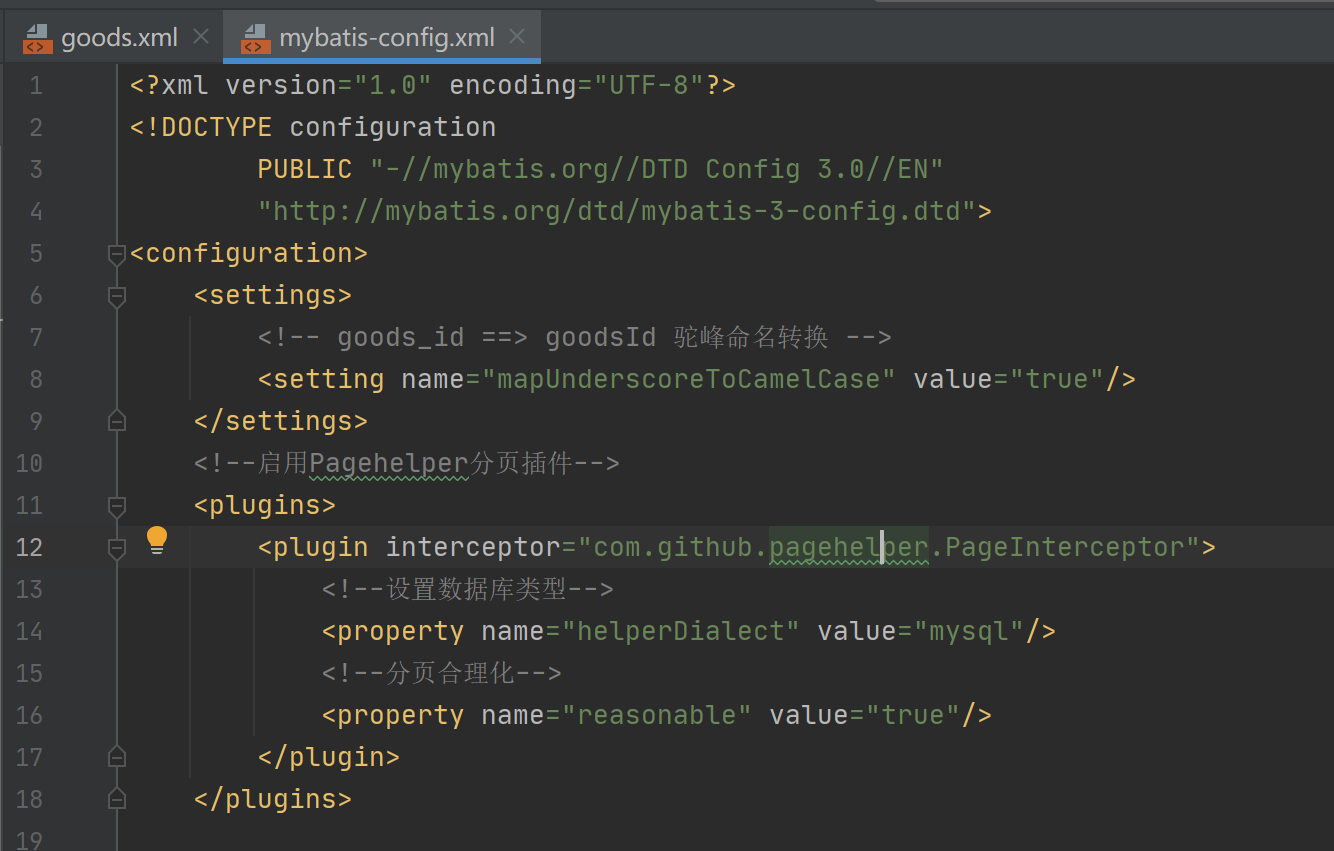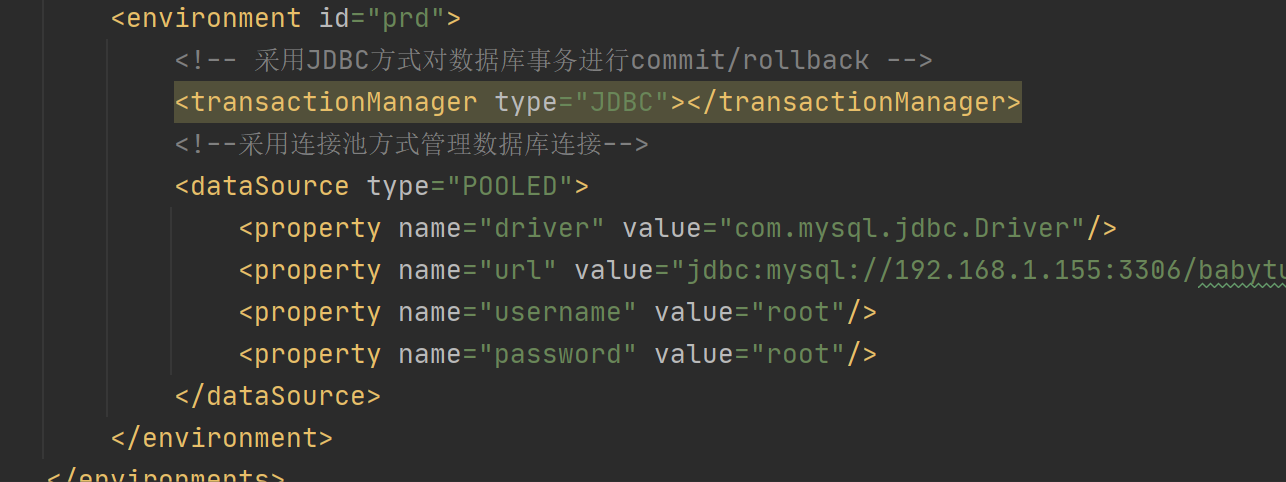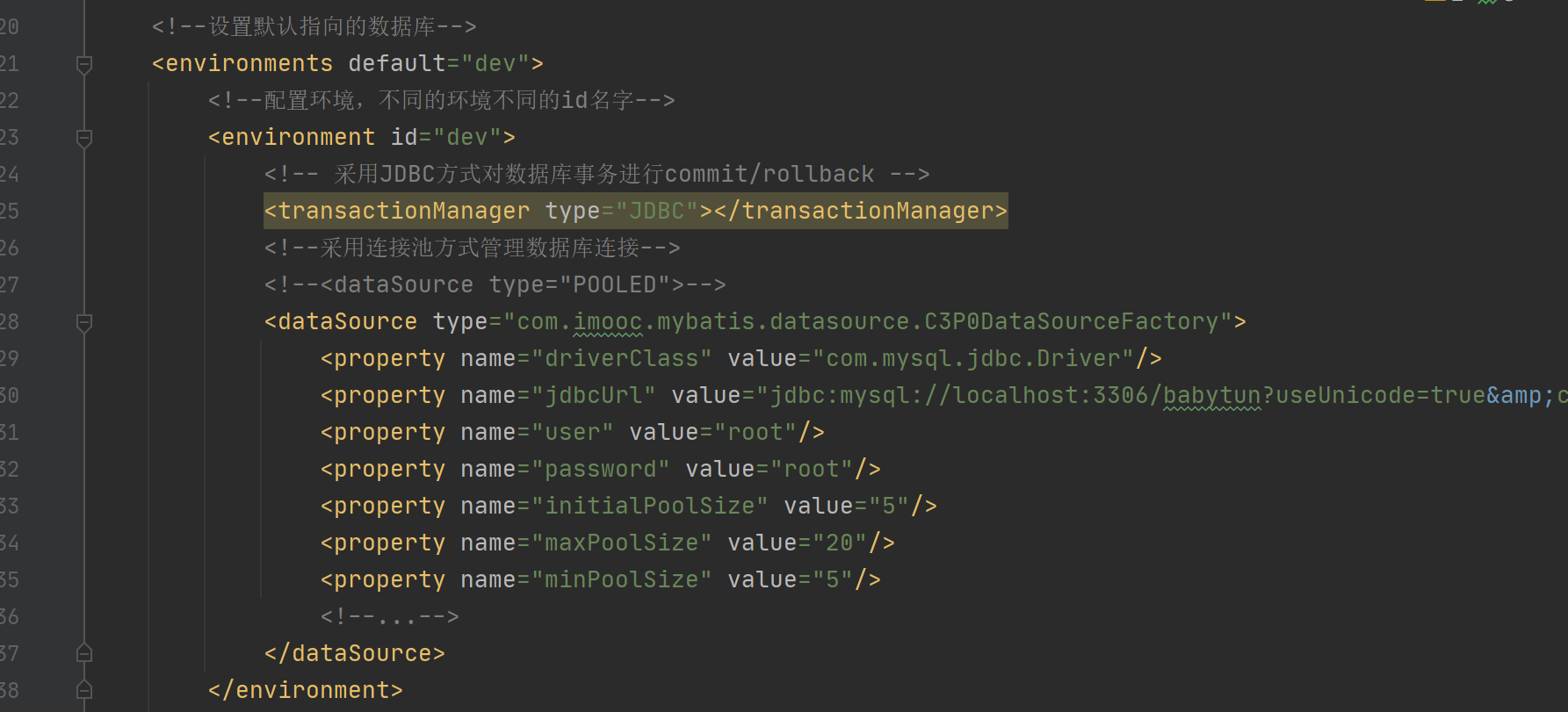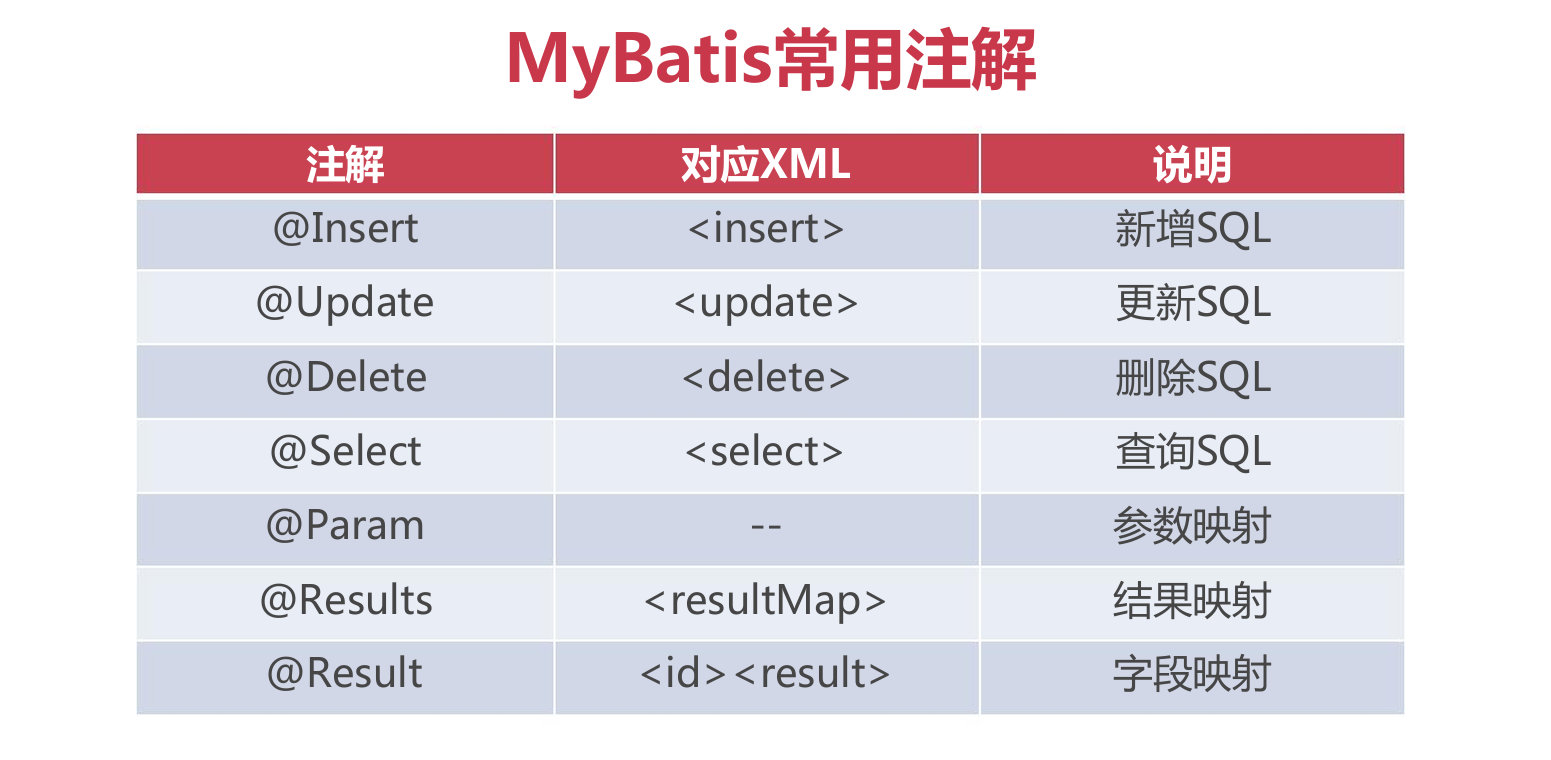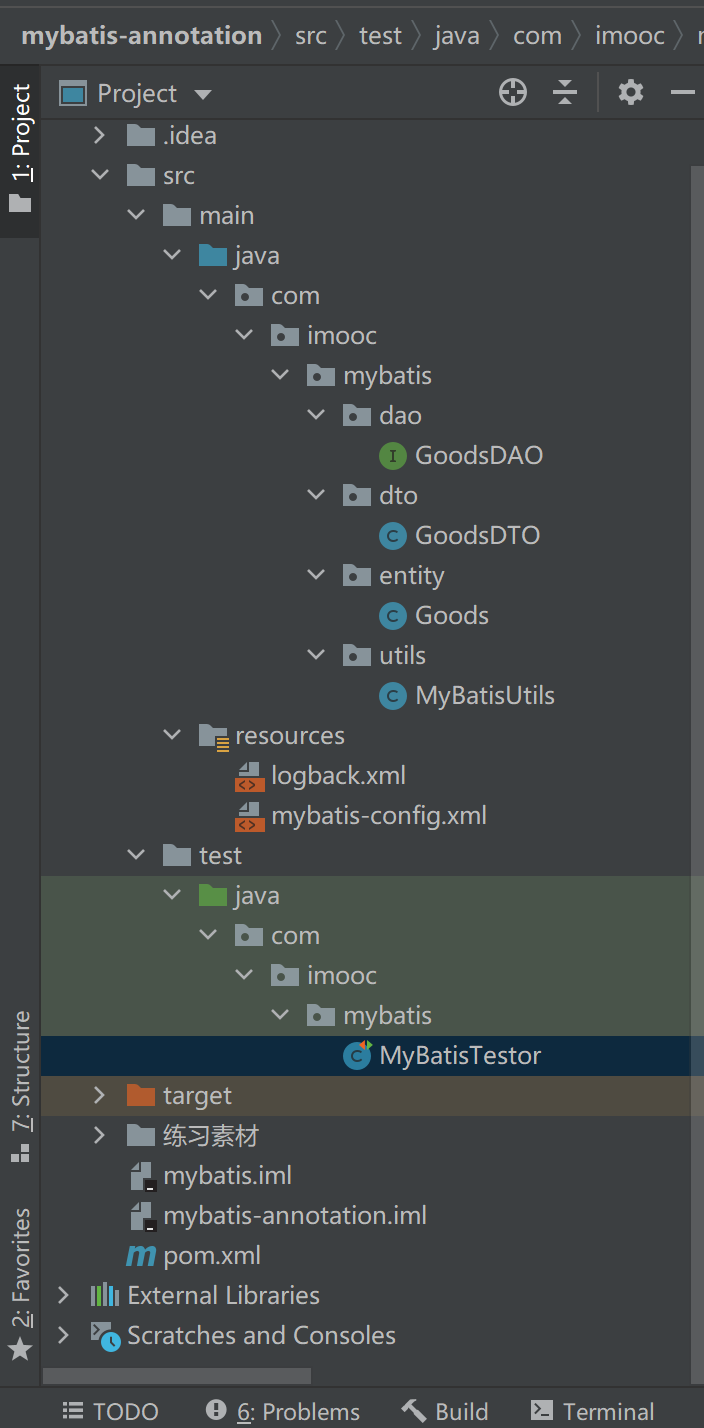MyBatis
1.内容介绍
2.介绍MyBatis
什么是MyBatis?
- MyBatis是优秀的持久层框架
- MyBatis使用XML将SQL与程序解耦,便于维护
- MyBatis学习简单,执行高效,是JDBC的延伸
MyBatis开发流程
- 引入MyBatis依赖
- 创建核心配置文件
- 创建实体(Entity)类
- 创建Mapper映射文件
- 初始化SessionFactory
- 利用SqlSession对象操作数据
3.单元测试与JUnit4
单元测试
- 单元测试是指对软件中的最小可测试单元进行检查和验证
- 测试用例是指编写一段代码对已有功能(方法)进行校验
- JUnit 4是Java中最著名的单元测试工具,主流IDE内置支持
JUnit 4使用方法
- 引入JUnit Jar包或增加Maven依赖
- 编写测试用例验证目标方法是否正确运行
- 在测试用例上增加@Test注解开始单元测试
在pom.xml文件引入依赖:
<?xml version="1.0" encoding="UTF-8"?>
<project xmlns="http://maven.apache.org/POM/4.0.0"
xmlns:xsi="http://www.w3.org/2001/XMLSchema-instance"
xsi:schemaLocation="http://maven.apache.org/POM/4.0.0 http://maven.apache.org/xsd/maven-4.0.0.xsd">
<modelVersion>4.0.0</modelVersion>
<groupId>com.imooc</groupId>
<artifactId>maven-junit4</artifactId>
<version>1.0-SNAPSHOT</version>
<dependencies>
<dependency>
<groupId>junit</groupId>
<artifactId>junit</artifactId>
<version>4.12</version>
</dependency>
</dependencies>
</project>
编写Calculator类
package com.imooc.junit;
public class Calculator {
//加法运算
public int add(int a , int b){
return a + b;
}
//减法运算
public int subtract(int a , int b){
return a - b;
}
//乘法运算
public int multiply(int a , int b){
return a * b;
}
//除法运算
public float divide(int a,int b){
if(b==0){
throw new ArithmeticException("除数不能为0");
}
return (a*1f) / b;
}
}
编写CalculatorTest类验证各个方法
package com.imooc.junit;
import org.junit.Test;
import static org.junit.Assert.*;
public class CalculatorTest {
private Calculator cal = new Calculator();
@Test
public void add() {
int result = cal.add(1, 2);
System.out.println(result);
}
@Test
public void subtract() {
int result = cal.subtract(1, 2);
System.out.println(result);
}
@Test
public void multiply() {
int result = cal.multiply(1, 2);
System.out.println(result);
}
@Test
public void divide() {
float result = cal.divide(1, 2);
System.out.println(result);
}
}
4. MyBatis环境配置
首先在pom.xml中加入依赖
然后新增mybatis-config.xml文件配置数据库环境信息,内容如下:
<?xml version="1.0" encoding="UTF-8"?>
<!DOCTYPE configuration
PUBLIC "-//mybatis.org//DTD Config 3.0//EN"
"http://mybatis.org/dtd/mybatis-3-config.dtd">
<configuration>
<!--设置默认指向的数据库-->
<environments default="dev">
<!--配置环境,不同的环境不同的id名字-->
<environment id="dev">
<!-- 采用JDBC方式对数据库事务进行commit/rollback -->
<transactionManager type="JDBC"></transactionManager>
<!--采用连接池方式管理数据库连接-->
<dataSource type="POOLED">
<property name="driver" value="com.mysql.jdbc.Driver"/>
<property name="url" value="jdbc:mysql://192.168.1.155:3306/babytun?useUnicode=true&characterEncoding=UTF-8"/>
<property name="username" value="root"/>
<property name="password" value="root"/>
</dataSource>
</environment>
</environments>
</configuration>
5. SqlSessionFactory
创建MyBatisTestor类,获取SqlSessionFactory和SqlSession对象
//JUNIT单元测试类
public class MyBatisTestor {
/**
* 初始化SqlSessionFactory
* @throws IOException
*/
@Test
public void testSqlSessionFactory() throws IOException {
//利用Reader加载classpath下的mybatis-config.xml核心配置文件
Reader reader = Resources.getResourceAsReader("mybatis-config.xml");
//初始化SqlSessionFactory对象,同时解析mybatis-config.xml文件
SqlSessionFactory sqlSessionFactory = new SqlSessionFactoryBuilder().build(reader);
System.out.println("SessionFactory加载成功");
SqlSession sqlSession = null;
try {
//创建SqlSession对象,SqlSession是JDBC的扩展类,用于与数据库交互
sqlSession = sqlSessionFactory.openSession();
//创建数据库连接(测试用)
Connection connection = sqlSession.getConnection();
System.out.println(connection);
}catch (Exception e){
e.printStackTrace();
}finally {
if(sqlSession != null){
//如果type="POOLED",代表使用连接池,close则是将连接回收到连接池中
//如果type="UNPOOLED",代表直连,close则会调用Connection.close()方法关闭连接
sqlSession.close();
}
}
}
}
6. MyBatis数据查询
初始化工具类
初始化工具类MyBatisUtils,使得SqlSessionFactory全局唯一
/**
* MyBatisUtils工具类,创建全局唯一的SqlSessionFactory对象
*/
public class MyBatisUtils {
//利用static(静态)属于类不属于对象,且全局唯一
private static SqlSessionFactory sqlSessionFactory = null;
//利用静态块在初始化类时实例化sqlSessionFactory
static {
Reader reader = null;
try {
reader = Resources.getResourceAsReader("mybatis-config.xml");
sqlSessionFactory = new SqlSessionFactoryBuilder().build(reader);
} catch (IOException e) {
e.printStackTrace();
//初始化错误时,通过抛出异常ExceptionInInitializerError通知调用者
throw new ExceptionInInitializerError(e);
}
}
/**
* openSession 创建一个新的SqlSession对象
* @return SqlSession对象
*/
public static SqlSession openSession(){
return sqlSessionFactory.openSession();
}
/**
* 释放一个有效的SqlSession对象
* @param session 准备释放SqlSession对象
*/
public static void closeSession(SqlSession session){
if(session != null){
session.close();
}
}
}
于是可以直接通过openSession方法获取SqlSession对象,closeSession释放SqlSession对象
MyBatis数据查询
生成实体操作
package com.imooc.mybatis.entity;
import java.util.List;
public class Goods {
private Integer goodsId;//商品编号
private String title;//标题
private String subTitle;//子标题
private Float originalCost;//原始价格
private Float currentPrice;//当前价格
private Float discount;//折扣率
private Integer isFreeDelivery;//是否包邮 ,1-包邮 0-不包邮
private Integer categoryId;//分类编号
private List<GoodsDetail> goodsDetails;
public Integer getGoodsId() {
return goodsId;
}
public void setGoodsId(Integer goodsId) {
this.goodsId = goodsId;
}
public String getTitle() {
return title;
}
public void setTitle(String title) {
this.title = title;
}
public String getSubTitle() {
return subTitle;
}
public void setSubTitle(String subTitle) {
this.subTitle = subTitle;
}
public Float getOriginalCost() {
return originalCost;
}
public void setOriginalCost(Float originalCost) {
this.originalCost = originalCost;
}
public Float getCurrentPrice() {
return currentPrice;
}
public void setCurrentPrice(Float currentPrice) {
this.currentPrice = currentPrice;
}
public Float getDiscount() {
return discount;
}
public void setDiscount(Float discount) {
this.discount = discount;
}
public Integer getIsFreeDelivery() {
return isFreeDelivery;
}
public void setIsFreeDelivery(Integer isFreeDelivery) {
this.isFreeDelivery = isFreeDelivery;
}
public Integer getCategoryId() {
return categoryId;
}
public void setCategoryId(Integer categoryId) {
this.categoryId = categoryId;
}
public List<GoodsDetail> getGoodsDetails() {
return goodsDetails;
}
public void setGoodsDetails(List<GoodsDetail> goodsDetails) {
this.goodsDetails = goodsDetails;
}
}
生成映射器mapper,goods.xml文件,说明对象和表的映射关系
<?xml version="1.0" encoding="UTF-8"?>
<!DOCTYPE mapper
PUBLIC "-//mybatis.org//DTD Mapper 3.0//EN"
"http://mybatis.org/dtd/mybatis-3-mapper.dtd">
<mapper namespace="goods">
<select id="selectAll" resultType="com.imooc.mybatis.entity.Goods" useCache="false">
select * from t_goods order by goods_id desc limit 10
</select>
</mapper>
在mybatis-config.xml中进行声明,这样mybatis在初始化时才知道goods.xml的存在
<mappers>
<mapper resource="mappers/goods.xml"/>
</mappers>
接着打开测试用例类MyBatisTestor.java,执行该selectAll语句得到结果
/**
* select查询语句执行
* @throws Exception
*/
@Test
public void testSelectAll() throws Exception {
SqlSession session = null;
try{
session = MyBatisUtils.openSession();
//参数为命名空间.语句ID
List<Goods> list = session.selectList("goods.selectAll");
for(Goods g : list){
System.out.println(g.getTitle());
}
}catch (Exception e){
throw e;
}finally {
MyBatisUtils.closeSession(session);
}
}
另:mybatis-config.xml中设置驼峰命名转换,有些属性获取不到的数据也能正常获取到了
<settings>
<!-- goods_id ==> goodsId 驼峰命名转换 -->
<setting name="mapUnderscoreToCamelCase" value="true"/>
</settings>
7. SQL传参
goods.xml
<!-- 单参数传递,使用parameterType指定参数的数据类型即可,SQL中#{value}提取参数-->
<select id="selectById" parameterType="Integer" resultType="com.imooc.mybatis.entity.Goods">
select * from t_goods where goods_id = #{value}
</select>
<!-- 多参数传递时,使用parameterType指定Map接口,SQL中#{key}提取参数 -->
<select id="selectByPriceRange" parameterType="java.util.Map" resultType="com.imooc.mybatis.entity.Goods">
select * from t_goods
where
current_price between #{min} and #{max}
order by current_price
limit 0,#{limt}
</select>
MyBatisTestor.java
/**
* 传递单个SQL参数
* @throws Exception
*/
@Test
public void testSelectById() throws Exception {
SqlSession session = null;
try{
session = MyBatisUtils.openSession();
Goods goods = session.selectOne("goods.selectById" , 1603);
System.out.println(goods.getTitle());
}catch (Exception e){
throw e;
}finally {
MyBatisUtils.closeSession(session);
}
}
/**
* 传递多个SQL参数
* @throws Exception
*/
@Test
public void testSelectByPriceRange() throws Exception {
SqlSession session = null;
try{
session = MyBatisUtils.openSession();
Map param = new HashMap();
param.put("min",100);
param.put("max" , 500);
param.put("limt" , 10);
List<Goods> list = session.selectList("goods.selectByPriceRange", param);
for(Goods g:list){
System.out.println(g.getTitle() + ":" + g.getCurrentPrice());
}
}catch (Exception e){
throw e;
}finally {
MyBatisUtils.closeSession(session);
}
}
8. 获取多表关联查询结果
大量企业级应用都是多表联合查询产生一个复杂的结果集
goods.xml
<!-- 利用LinkedHashMap保存多表关联结果
MyBatis会将每一条记录包装为LinkedHashMap对象
key是字段名 value是字段对应的值 , 字段类型根据表结构进行自动判断
优点: 易于扩展,易于使用
缺点: 太过灵活,无法进行编译时检查
-->
<select id="selectGoodsMap" resultType="java.util.LinkedHashMap" flushCache="true">
select g.* , c.category_name,'1' as test from t_goods g , t_category c
where g.category_id = c.category_id
</select>
MyBatisTestor.java
/**
* 利用Map接收关联查询结果
* @throws Exception
*/
@Test
public void testSelectGoodsMap() throws Exception {
SqlSession session = null;
try{
session = MyBatisUtils.openSession();
List<Map> list = session.selectList("goods.selectGoodsMap");
for(Map map : list){
System.out.println(map);
}
}catch (Exception e){
throw e;
}finally {
MyBatisUtils.closeSession(session);
}
}
9. ResultMap结果映射
用对象保存多表关联查询的数据
创建一个全新的类GoodDTO,不要破坏Goods类
package com.imooc.mybatis.dto;
import com.imooc.mybatis.entity.Category;
import com.imooc.mybatis.entity.Goods;
//Data Transfer Object--数据传输对象
public class GoodsDTO {
private Goods goods = new Goods();
private Category category = new Category();
private String test;
public Goods getGoods() {
return goods;
}
public void setGoods(Goods goods) {
this.goods = goods;
}
public Category getCategory() {
return category;
}
public void setCategory(Category category) {
this.category = category;
}
public String getTest() {
return test;
}
public void setTest(String test) {
this.test = test;
}
}
使用ResultMap结果映射,使得mybatis自动为该类对象的属性赋值
goods.xml
<!--结果映射-->
<resultMap id="rmGoods" type="com.imooc.mybatis.dto.GoodsDTO">
<!--设置主键字段与属性映射-->
<id property="goods.goodsId" column="goods_id"></id>
<!--设置非主键字段与属性映射-->
<result property="goods.title" column="title"></result>
<result property="goods.originalCost" column="original_cost"></result>
<result property="goods.currentPrice" column="current_price"></result>
<result property="goods.discount" column="discount"></result>
<result property="goods.isFreeDelivery" column="is_free_delivery"></result>
<result property="goods.categoryId" column="category_id"></result>
<result property="category.categoryId" column="category_id"></result>
<result property="category.categoryName" column="category_name"></result>
<result property="category.parentId" column="parent_id"></result>
<result property="category.categoryLevel" column="category_level"></result>
<result property="category.categoryOrder" column="category_order"></result>
<result property="test" column="test"/>
</resultMap>
<select id="selectGoodsDTO" resultMap="rmGoods">
select g.* , c.*,'1' as test from t_goods g , t_category c
where g.category_id = c.category_id
</select>
MyBatisTestor.java
/**
* 利用ResultMap进行结果映射
* @throws Exception
*/
@Test
public void testSelectGoodsDTO() throws Exception {
SqlSession session = null;
try{
session = MyBatisUtils.openSession();
List<GoodsDTO> list = session.selectList("goods.selectGoodsDTO");
for (GoodsDTO g : list) {
System.out.println(g.getGoods().getTitle());
}
}catch (Exception e){
throw e;
}finally {
MyBatisUtils.closeSession(session);
}
}
10. MyBatis数据插入操作
要么数据全部插入成功,要么出现了问题全部回滚
goods.xml
<insert id="insert" parameterType="com.imooc.mybatis.entity.Goods">
INSERT INTO t_goods(title, sub_title, original_cost, current_price, discount, is_free_delivery, category_id)
VALUES (#{title} , #{subTitle} , #{originalCost}, #{currentPrice}, #{discount}, #{isFreeDelivery}, #{categoryId})
<selectKey resultType="Integer" keyProperty="goodsId" order="AFTER">
<!--获取当前连接最后产生的id号-->
select last_insert_id()
</selectKey>
</insert>
MyBatisTestor.java
/**
* 新增数据
* @throws Exception
*/
@Test
public void testInsert() throws Exception {
SqlSession session = null;
try{
session = MyBatisUtils.openSession();
Goods goods = new Goods();
goods.setTitle("测试商品");
goods.setSubTitle("测试子标题");
goods.setOriginalCost(200f);
goods.setCurrentPrice(100f);
goods.setDiscount(0.5f);
goods.setIsFreeDelivery(1);
goods.setCategoryId(43);
//insert()方法返回值代表本次成功插入的记录总数
int num = session.insert("goods.insert", goods);
session.commit();//提交事务数据
System.out.println(goods.getGoodsId());
}catch (Exception e){
if(session != null){
session.rollback();//回滚事务
}
throw e;
}finally {
MyBatisUtils.closeSession(session);
}
}
11. selectKey与useGeneratedKeys的区别
12. 更新与删除操作
goods.xml
<update id="update" parameterType="com.imooc.mybatis.entity.Goods">
UPDATE t_goods
SET
title = #{title} ,
sub_title = #{subTitle} ,
original_cost = #{originalCost} ,
current_price = #{currentPrice} ,
discount = #{discount} ,
is_free_delivery = #{isFreeDelivery} ,
category_id = #{categoryId}
WHERE
goods_id = #{goodsId}
</update>
<!--delete from t_goods where goods_id in (1920,1921)-->
<delete id="delete" parameterType="Integer">
delete from t_goods where goods_id = #{value}
</delete>
MyBatisTestor.java
/**
* 更新数据
* @throws Exception
*/
@Test
public void testUpdate() throws Exception {
SqlSession session = null;
try{
session = MyBatisUtils.openSession();
Goods goods = session.selectOne("goods.selectById", 739);
goods.setTitle("更新测试商品");
int num = session.update("goods.update" , goods);
session.commit();//提交事务数据
}catch (Exception e){
if(session != null){
session.rollback();//回滚事务
}
throw e;
}finally {
MyBatisUtils.closeSession(session);
}
}
/**
* 删除数据
* @throws Exception
*/
@Test
public void testDelete() throws Exception {
SqlSession session = null;
try{
session = MyBatisUtils.openSession();
int num = session.delete("goods.delete" , 739);
session.commit();//提交事务数据
}catch (Exception e){
if(session != null){
session.rollback();//回滚事务
}
throw e;
}finally {
MyBatisUtils.closeSession(session);
}
}
13. 预防SQL注入攻击
goods.xml
<select id="selectByTitle" parameterType="java.util.Map" resultType="com.imooc.mybatis.entity.Goods">
select * from t_goods where title = #{title}
${order}
</select>
/**
* 预防SQL注入
* @throws Exception
*/
@Test
public void testSelectByTitle() throws Exception {
SqlSession session = null;
try{
session = MyBatisUtils.openSession();
Map param = new HashMap();
/*
${}原文传值
select * from t_goods
where title = '' or 1 =1 or title = '【德国】爱他美婴幼儿配方奶粉1段800g*2罐 铂金版'
*/
/*
#{}预编译
select * from t_goods
where title = "'' or 1 =1 or title = '【德国】爱他美婴幼儿配方奶粉1段800g*2罐 铂金版'"
*/
param.put("title","'' or 1=1 or title='【德国】爱他美婴幼儿配方奶粉1段800g*2罐 铂金版'");
param.put("order" , " order by title desc");
List<Goods> list = session.selectList("goods.selectByTitle", param);
for(Goods g:list){
System.out.println(g.getTitle() + ":" + g.getCurrentPrice());
}
}catch (Exception e){
throw e;
}finally {
MyBatisUtils.closeSession(session);
}
}
14. MyBatis工作流程
第一步创建mybatis-config.xml文件,包含环境配置、全局配置项、mapper声明这样的核心配置信息,该文件起到全局配置的作用
第二步在程序运行的过程中,通过SqlSessionFactoryBuilder这个构建器对象来build构建SqlSessionFactory,SqlSessionFactory(全局唯一)用于创建SqlSession,SqlSession用于对数据表进行增删改查,其中SqlSession要解析与之对应的mapper.xml文件,每一个mapper文件中都包含了大量sql语句,通过SqlSession访问mapper.xml进而执行与之对应的sql语句,最后需要关闭SqlSession。
15. 第二章(进阶):MyBatis日志管理
通过统一的门面屏蔽了底层的实现
门面:为Java提供统一的日志调用接口
实现:有各种各样的组织开发不同的产品,提供具体实现
为程序迁移提供了极大遍历。
pom.xml增加依赖
<dependency>
<groupId>ch.qos.logback</groupId>
<artifactId>logback-classic</artifactId>
<version>1.2.3</version>
</dependency>
在控制台中会输出很多信息
logback.xml 提供logback配置项
<?xml version="1.0" encoding="UTF-8"?>
<configuration>
<appender name="console" class="ch.qos.logback.core.ConsoleAppender">
<encoder>
<!-- 规定日志输出的格式-->
<pattern>[%thread] %d{HH:mm:ss.SSS} %-5level %logger{36} - %msg%n</pattern>
</encoder>
</appender>
<!--
日志输出级别(优先级高到低):
error: 错误 - 系统的故障日志
warn: 警告 - 存在风险或使用不当的日志
info: 一般性消息
debug: 程序内部用于调试信息
trace: 程序运行的跟踪信息
此时,debug级别及以上的信息都会输出
-->
<root level="debug">
<appender-ref ref="console"/>
</root>
</configuration>
16. MyBatis动态SQL
goods.xml
<select id="dynamicSQL" parameterType="java.util.Map" resultType="com.imooc.mybatis.entity.Goods">
select * from t_goods
<where>
<if test="categoryId != null">
and category_id = #{categoryId}
</if>
<if test="currentPrice != null">
and current_price < #{currentPrice}
</if>
</where>
</select>
MyBatisTestor.java
/**
* 动态SQL语句
* @throws Exception
*/
@Test
public void testDynamicSQL() throws Exception {
SqlSession session = null;
try{
session = MyBatisUtils.openSession();
Map param = new HashMap();
param.put("categoryId", 44);
param.put("currentPrice", 500);
//查询条件
List<Goods> list = session.selectList("goods.dynamicSQL", param);
for(Goods g:list){
System.out.println(g.getTitle() + ":" +
g.getCategoryId() + ":" + g.getCurrentPrice());
}
}catch (Exception e){
throw e;
}finally {
MyBatisUtils.closeSession(session);
}
}
17. MyBatis二级缓存
用于数据优化,提高效率
比如用sql语句第一次查询时获得了婴幼儿奶粉的数据,紧接着,因为某种需要,还需要再获取一次婴幼儿奶粉的数据,按照原先的设计,需要再次从数据库中提取出来,可MySQL是把数据存储在硬盘上的,硬盘提取的速度并不是很快,若要进行优化,则可以使用缓存,直接从内存中提取。
一级缓存
/**
* 测试一级缓存
* @throws Exception
*/
@Test
public void testLv1Cache() throws Exception {
SqlSession session = null;
try{
session = MyBatisUtils.openSession();
Goods goods = session.selectOne("goods.selectById" , 1603);
Goods goods1 = session.selectOne("goods.selectById" , 1603);
System.out.println(goods.hashCode() + ":" + goods1.hashCode());
}catch (Exception e){
throw e;
}finally {
MyBatisUtils.closeSession(session);
}
try{
session = MyBatisUtils.openSession();
Goods goods = session.selectOne("goods.selectById" , 1603);
session.commit();//commit提交时对该namespace缓存强制清空
Goods goods1 = session.selectOne("goods.selectById" , 1603);
System.out.println(goods.hashCode() + ":" + goods1.hashCode());
}catch (Exception e){
throw e;
}finally {
MyBatisUtils.closeSession(session);
}
}
第一个try块里面的两个hashCode()返回值相同,第二个try块中,由于对commit提交时对该namespace缓存强制清空,两个hashCode()返回值不同
二级缓存
手动开启,在对应的xml文件中增加配置
goods.xml:
/**
* 测试二级缓存
* @throws Exception
*/
@Test
public void testLv2Cache() throws Exception {
SqlSession session = null;
try{
session = MyBatisUtils.openSession();
Goods goods = session.selectOne("goods.selectById" , 1603);
System.out.println(goods.hashCode());
}catch (Exception e){
throw e;
}finally {
MyBatisUtils.closeSession(session);
}
try{
session = MyBatisUtils.openSession();
Goods goods = session.selectOne("goods.selectById" , 1603);
System.out.println(goods.hashCode());
}catch (Exception e){
throw e;
}finally {
MyBatisUtils.closeSession(session);
}
}
此时从控制台的输出可以看到,只执行了一次sql语句,并且内存地址是一样的。
18. 对象关联查询
OneToMany对象关联查询
接下来进行商品和详情对象关联查询,商品为1的一方,详情为多的一方。
首先创建goods_detail对象
package com.imooc.mybatis.entity;
public class GoodsDetail {
private Integer gdId;
private Integer goodsId;
private String gdPicUrl;
private Integer gdOrder;
private Goods goods;
public Integer getGdId() {
return gdId;
}
public void setGdId(Integer gdId) {
this.gdId = gdId;
}
public Integer getGoodsId() {
return goodsId;
}
public void setGoodsId(Integer goodsId) {
this.goodsId = goodsId;
}
public String getGdPicUrl() {
return gdPicUrl;
}
public void setGdPicUrl(String gdPicUrl) {
this.gdPicUrl = gdPicUrl;
}
public Integer getGdOrder() {
return gdOrder;
}
public void setGdOrder(Integer gdOrder) {
this.gdOrder = gdOrder;
}
public Goods getGoods() {
return goods;
}
public void setGoods(Goods goods) {
this.goods = goods;
}
}
Goods.java中,
private List<GoodsDetail> goodsDetails;
goods.xml
<!--
resultMap可用于说明一对多或者多对一的映射逻辑
id 是resultMap属性引用的标志
type 指向One的实体(Goods)
-->
<resultMap id="rmGoods1" type="com.imooc.mybatis.entity.Goods">
<!-- 映射goods对象的主键到goods_id字段 -->
<id column="goods_id" property="goodsId"></id>
<!--
collection的含义是,在
select * from t_goods limit 0,1 得到结果后,对所有Goods对象遍历得到goods_id字段值,
并代入到goodsDetail命名空间的findByGoodsId的SQL中执行查询,
将得到的"商品详情"集合赋值给goodsDetails List对象.
-->
<collection property="goodsDetails" select="goodsDetail.selectByGoodsId"
column="goods_id"/>
</resultMap>
<select id="selectOneToMany" resultMap="rmGoods1">
select * from t_goods limit 0,10
</select>
mybatis-config.xml新增
MyBatisTestor.java
/**
* 一对多对象关联查询
* @throws Exception
*/
@Test
public void testOneToMany() throws Exception {
SqlSession session = null;
try {
session = MyBatisUtils.openSession();
List<Goods> list = session.selectList("goods.selectOneToMany");
for(Goods goods:list) {
System.out.println(goods.getTitle() + ":" + goods.getGoodsDetails().size());
}
} catch (Exception e) {
throw e;
} finally {
MyBatisUtils.closeSession(session);
}
}
ManyToOne对象关联查询
GoodsDetail.java中
private Goods goods;
goods_detail.xml
<?xml version="1.0" encoding="UTF-8"?>
<!DOCTYPE mapper
PUBLIC "-//mybatis.org//DTD Mapper 3.0//EN"
"http://mybatis.org/dtd/mybatis-3-mapper.dtd">
<mapper namespace="goodsDetail">
<select id="selectByGoodsId" parameterType="Integer"
resultType="com.imooc.mybatis.entity.GoodsDetail">
select * from t_goods_detail where goods_id = #{value}
</select>
<resultMap id="rmGoodsDetail" type="com.imooc.mybatis.entity.GoodsDetail">
<id column="gd_id" property="gdId"/>
<result column="goods_id" property="goodsId"/>
<!-- 从多的一方关联一的一方-->
<association property="goods" select="goods.selectById" column="goods_id">
</association>
</resultMap>
<select id="selectManyToOne" resultMap="rmGoodsDetail">
select * from t_goods_detail limit 0,20
</select>
</mapper>
MyBatisTestor.java
/**
* 测试多对一对象关联映射
*/
@Test
public void testManyToOne() throws Exception {
SqlSession session = null;
try {
session = MyBatisUtils.openSession();
List<GoodsDetail> list = session.selectList("goodsDetail.selectManyToOne");
for(GoodsDetail gd:list) {
System.out.println(gd.getGdPicUrl() + ":" + gd.getGoods().getTitle());
}
} catch (Exception e) {
throw e;
} finally {
MyBatisUtils.closeSession(session);
}
}
19. 分页处理
pom.xml文件增加依赖
<dependency>
<groupId>com.github.pagehelper</groupId>
<artifactId>pagehelper</artifactId>
<version>5.1.10</version>
</dependency>
<dependency>
<groupId>com.github.jsqlparser</groupId>
<artifactId>jsqlparser</artifactId>
<version>2.0</version>
</dependency>
mybatis-config.xml增加配置
goods.xml
<select id="selectPage" resultType="com.imooc.mybatis.entity.Goods">
select * from t_goods where current_price < 1000
</select>
MyBatisTestor.java
@Test
/**
* PageHelper分页查询
*/
public void testSelectPage() throws Exception {
SqlSession session = null;
try {
session = MyBatisUtils.openSession();
/*startPage方法会自动将下一次查询进行分页 返回从第二页开始,每页10行的数据*/
PageHelper.startPage(2,10);
//返回page对象 不仅包含原始数据,还有分页的信息
Page<Goods> page = (Page) session.selectList("goods.selectPage");
System.out.println("总页数:" + page.getPages());
System.out.println("总记录数:" + page.getTotal());
System.out.println("开始行号:" + page.getStartRow());
System.out.println("结束行号:" + page.getEndRow());
System.out.println("当前页码:" + page.getPageNum());
List<Goods> data = page.getResult();//当前页数据
for (Goods g : data) {
System.out.println(g.getTitle());
}
System.out.println("");
} catch (Exception e) {
throw e;
} finally {
MyBatisUtils.closeSession(session);
}
}
20. MyBatis整合C3P0连接池
加入依赖
<dependency>
<groupId>com.mchange</groupId>
<artifactId>c3p0</artifactId>
<version>0.9.5.4</version>
</dependency>
这里的type为POOLED 表示使用的是mybatis自己的连接池,但主流应用开发中,并不会使用mybatis自带的,有更好的连接池。
若需要mybatis进行支持C3P0连接池,需要额外扩展一个类 C3P0DataSourceFactory
/**
* C3P0与MyBatis兼容使用的数据源工厂类
*/
public class C3P0DataSourceFactory extends UnpooledDataSourceFactory {
public C3P0DataSourceFactory(){
this.dataSource = new ComboPooledDataSource();
}
}
然后在mybatis-config.xml中
同时属性的命名要求需要相应更改
比如原来的property名称url需要改为jdbcUrl等
MyBatisTestor.java
/**
* 批量插入测试
* @throws Exception
*/
@Test
public void testBatchInsert() throws Exception {
SqlSession session = null;
try {
long st = new Date().getTime();
session = MyBatisUtils.openSession();
List list = new ArrayList();
for (int i = 0; i < 10000; i++) {
Goods goods = new Goods();
goods.setTitle("测试商品");
goods.setSubTitle("测试子标题");
goods.setOriginalCost(200f);
goods.setCurrentPrice(100f);
goods.setDiscount(0.5f);
goods.setIsFreeDelivery(1);
goods.setCategoryId(43);
//insert()方法返回值代表本次成功插入的记录总数
list.add(goods);
}
session.insert("goods.batchInsert", list);
session.commit();//提交事务数据
long et = new Date().getTime();
System.out.println("执行时间:" + (et - st) + "毫秒");
// System.out.println(goods.getGoodsId());
} catch (Exception e) {
if (session != null) {
session.rollback();//回滚事务
}
throw e;
} finally {
MyBatisUtils.closeSession(session);
}
}
21. MyBatis批处理
利用集合保存批处理的数据,然后再利用批处理sql一次性完成,提供程序执行效率
goods.xml
<!--INSERT INTO table-->
<!--VALUES ("a" , "a1" , "a2"),("b" , "b1" , "b2"),(....)-->
<!--设置与迭代相关的属性,list表示数据源 也就是从外侧传入的数据源集合,item表示循环中的循环变量,index表示循环的索引,separator为逗号,也就是values那一行,都是以逗号分割一个个对象的-->
<insert id="batchInsert" parameterType="java.util.List">
INSERT INTO t_goods(title, sub_title, original_cost, current_price, discount, is_free_delivery, category_id)
VALUES
<foreach collection="list" item="item" index="index" separator=",">
(#{item.title},#{item.subTitle}, #{item.originalCost}, #{item.currentPrice}, #{item.discount}, #{item.isFreeDelivery}, #{item.categoryId})
</foreach>
</insert>
<!--in (1901,1902)-->
<delete id="batchDelete" parameterType="java.util.List">
DELETE FROM t_goods WHERE goods_id in
<foreach collection="list" item="item" index="index" open="(" close=")" separator=",">
#{item}
</foreach>
</delete>
MyBatisTestor.java
/**
* 批量删除测试
* @throws Exception
*/
@Test
public void testBatchDelete() throws Exception {
SqlSession session = null;
try {
long st = new Date().getTime();
session = MyBatisUtils.openSession();
List list = new ArrayList();
list.add(1920);
list.add(1921);
list.add(1922);
session.delete("goods.batchDelete", list);
session.commit();//提交事务数据
long et = new Date().getTime();
System.out.println("执行时间:" + (et - st) + "毫秒");
// System.out.println(goods.getGoodsId());
} catch (Exception e) {
if (session != null) {
session.rollback();//回滚事务
}
throw e;
} finally {
MyBatisUtils.closeSession(session);
}
}
22.Mybatis注解开发方式
注解的作用就是替换掉xml的各种标签,简化程序配置过程
在mybatis-config.xml中进行基本配置,保留了驼峰转换和dev数据源,里面没有任何mapper映射
<?xml version="1.0" encoding="UTF-8"?>
<!DOCTYPE configuration
PUBLIC "-//mybatis.org//DTD Config 3.0//EN"
"http://mybatis.org/dtd/mybatis-3-config.dtd">
<configuration>
<settings>
<!-- goods_id ==> goodsId 驼峰命名转换 -->
<setting name="mapUnderscoreToCamelCase" value="true"/>
</settings>
<!--设置默认指向的数据库-->
<environments default="dev">
<!--配置环境,不同的环境不同的id名字-->
<environment id="dev">
<!-- 采用JDBC方式对数据库事务进行commit/rollback -->
<transactionManager type="JDBC"></transactionManager>
<!--采用连接池方式管理数据库连接-->
<dataSource type="POOLED">
<property name="driver" value="com.mysql.jdbc.Driver"/>
<property name="url" value="jdbc:mysql://localhost:3306/babytun?useUnicode=true&characterEncoding=UTF-8"/>
<property name="username" value="root"/>
<property name="password" value="root"/>
</dataSource>
</environment>
</environments>
</configuration>
文件夹结构如下:
不需要mapper文件,但需要创建GoodsDAO这个接口,利用接口+注解替代原有xml文件
package com.imooc.mybatis.dao;
import com.imooc.mybatis.dto.GoodsDTO;
import com.imooc.mybatis.entity.Goods;
import org.apache.ibatis.annotations.*;
import java.util.List;
public interface GoodsDAO {
//基本查询 这三个参数增加@Param()使得参数与sql的参数一一对应
@Select("select * from t_goods where current_price between #{min} and #{max} order by current_price limit 0,#{limt}")
public List<Goods> selectByPriceRange(@Param("min") Float min ,@Param("max") Float max ,@Param("limt") Integer limt);
@Insert("INSERT INTO t_goods(title, sub_title, original_cost, current_price, discount, is_free_delivery, category_id) VALUES (#{title} , #{subTitle} , #{originalCost}, #{currentPrice}, #{discount}, #{isFreeDelivery}, #{categoryId})")
//<selectKey>
@SelectKey(statement = "select last_insert_id()" , before = false , keyProperty = "goodsId" , resultType = Integer.class)
public int insert(Goods goods);
@Select("select * from t_goods")
//<resultMap>
//进行结果映射
@Results({
//<id>
@Result(column = "goods_id" ,property = "goodsId" , id = true) ,
//<result>
@Result(column = "title" ,property = "title"),
@Result(column = "current_price" ,property = "currentPrice")
})
public List<GoodsDTO> selectAll();
}
在mybatis-config.xml中增加相应说明
<mappers>
<!--<mapper class="com.imooc.mybatis.dao.GoodsDAO"/>-->
<package name="com.imooc.mybatis.dao"/>
</mappers>
MyBatisTestor.java
package com.imooc.mybatis;
import com.imooc.mybatis.dao.GoodsDAO;
import com.imooc.mybatis.dto.GoodsDTO;
import com.imooc.mybatis.entity.Goods;
import com.imooc.mybatis.utils.MyBatisUtils;
import org.apache.ibatis.session.SqlSession;
import org.junit.Test;
import java.util.List;
//JUNIT单元测试类
public class MyBatisTestor {
@Test
public void testSelectByPriceRange() throws Exception {
SqlSession session = null;
try{
session = MyBatisUtils.openSession();
GoodsDAO goodsDAO = session.getMapper(GoodsDAO.class);
List<Goods> list = goodsDAO.selectByPriceRange(100f, 500f, 20);
System.out.println(list.size());
}catch (Exception e){
throw e;
} finally {
MyBatisUtils.closeSession(session);
}
}
/**
* 新增数据
* @throws Exception
*/
@Test
public void testInsert() throws Exception {
SqlSession session = null;
try{
session = MyBatisUtils.openSession();
Goods goods = new Goods();
goods.setTitle("测试商品");
goods.setSubTitle("测试子标题");
goods.setOriginalCost(200f);
goods.setCurrentPrice(100f);
goods.setDiscount(0.5f);
goods.setIsFreeDelivery(1);
goods.setCategoryId(43);
GoodsDAO goodsDAO = session.getMapper(GoodsDAO.class);
//insert()方法返回值代表本次成功插入的记录总数
int num = goodsDAO.insert(goods);
session.commit();//提交事务数据
System.out.println(goods.getGoodsId());
}catch (Exception e){
if(session != null){
session.rollback();//回滚事务
}
throw e;
}finally {
MyBatisUtils.closeSession(session);
}
}
@Test
public void testSelectAll() throws Exception {
SqlSession session = null;
try{
session = MyBatisUtils.openSession();
GoodsDAO goodsDAO = session.getMapper(GoodsDAO.class);
List<GoodsDTO> list = goodsDAO.selectAll();
System.out.println(list.size());
}catch (Exception e){
throw e;
} finally {
MyBatisUtils.closeSession(session);
}
}
}
